David Selwyn, Edmund Geste and his books
APPENDIX X
Index of provenances and former owners
The index of provenances that follows is no more than provisional. The transcription of the ownership inscriptions in many instances is uncertain (some are crossed through, erased or sheared), and the identification of former owners in Venn and other biographical resources has often proved equally problematic. I am very grateful to Dr Elisabeth Leedham-Green and Pamela Selwyn, who have examined images of many of these difficult cases and suggested transcriptions and identifications which had eluded me. I must also thank Dr David Shaw for some additional corrections and suggestions in preparing this Appendix for the Bibliographical Society’s website. Further corrections would be welcome and these should be sent to the author at d.selwyn@clara.co.uk.
In the Index entries, the name of the former owner is given as the heading (where this has been identified), followed on the next line by brief details of the book in which the provenance inscription occurs, with the catalogue number, shelf-mark and present binding. The inscription itself and other relevant information (such as initials stamped on the covers) follows, with biographical details of the former owner and any references to complete the entry.
Abbreviations:
| CT | Centre-tool binding, or binding with a centre-tool. |
| MS | Manuscript leaves. |
| MS+ | Strip from a MS used as a binding strengthener. |
| PT | Parchment covers. |
| PNL | Panel-binding. |
| R | Rebound volume. |
| RL | Roll-binding. |
| † | Pre-Geste ownership inscription |
| ‡ | Pre-Geste MS annotations, book-price or book-title(s) on fore-edge or spine. |
| * | Sheared or trace only. |
The tabular information, printed in grey type below, is laid out in the following columns
| Imprint | Author | Cat. no. | Shelf-mark | annotation |
Appleby, John
| 1566 | Nowell, A. | N14 | O.1.16 | PT |
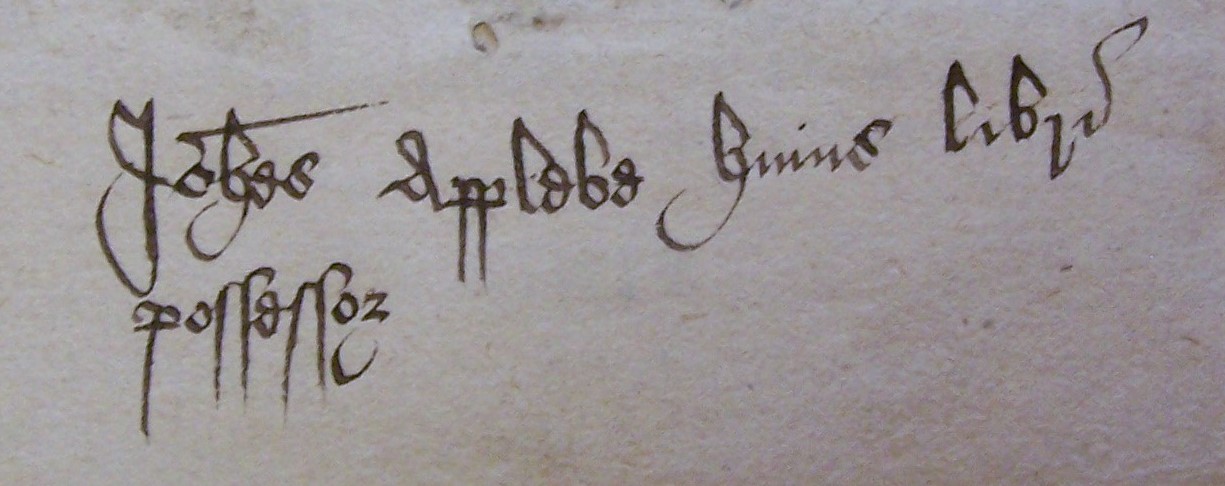
‘Joh[ann]es Applebe huius libri possessor’;
‘H K’ stamped in gold on front and back covers (see under K., H. below).
Venn records a pensioner of this name who matriculated at St John’s Cambridge, Easter 1568.
Arundel, Henry Fitzalan, Earl of
| [1550] | Amsdorff, N. | A28 | L.5.22 | R |
‘Arundel’ on titlepage.
12th Earl of Arundel (1512-1579), Henry Fitzalan, who obtained much of Thomas Cranmer’s library after its confiscation by the Crown in 1553. Presumably, this was an item not passed on to his son-in-law John, Lord Lumley, when his library was amalgamated with Lumley’s sometime after 1557.
Atkinson, R[ichard]. See also Skypton, G.
| [c. 1508] | Eusebius | E56 | A.6.32(e) | R |
‘teste R. Atkynson’
| 1529 | Augustine | A62 | A.6.32(a) | R |
‘teste R. Atkynson’
Older contemporary of Geste’s at King’s College, Cambridge, and his predecessor as vice-Provost, and Provost after Sir John Cheke (1553–1556). Born at Ripley, Yorks., and admitted to King’s in 1527 as a scholar from Eton (like Geste). Fellow 1530–1548; BA 1531–1532; MA 1535; BD 1542; DD 1545. Vice-provost of King’s 1542-1548 immediately before Geste. Lady Margaret Preacher, 1545. Rector of Stower, Dorset, 1547–1556. Provost of King’s 1553–1556 at the time Geste was expelled from the college (1554). Rector of Woodchurch, Kent. Incorporated his Cambridge degrees at Oxford in 1554 on his visit there to dispute with the Protestants on trial. Died of the plague in 1556. Will proved (King’s Coll. Sept. 15 [1556]). Venn.
Bagley, William. See also Skypton, G.
| [c.1508] | Augustine | A62 | A.6.32(a) | R |
‘teste G. Baggleo’.
Possibly the William Bagley from Warwickshire who was admitted to King’s College as a scholar from Eton on 12 Sept. 1530. BA 1531/32. Fellow (1530). Venn.
Bambrogh [Bamburgh], Ioannes, Vicar of Mallynge [Kent].
See Rochester, St Andrew, Benedictine Cathedral Priory
Blanckard, Eurard[?]
| 1567 | Petit, G. | *P2 | B.5.39 | R |
.jpg)
‘Ornatissimo viro, Eurardo Bla[?]nckardo, amico optatissimo, in Germaniam discedens d.d. Joannes Boulenius’ on tp.
Unidentified. Geste’s ownership of this book is far from certain.
Blithman[?], William
| 1527 | Thucydides | *T3 | Y.3.19(c) | RL |
.jpg)
‘Williu[m] Blithman[?]’ on p. 234 in a sixteenth-century hand.
This Blythman or Blithman not identified. Not in Venn.
See also under J., D.
Blomefyld, Wyllm.
| 1519 | Gratian | G30 | H.2.54 | R |
‘Wyllm Blomefyld’ in red ink in a page covered with annotations in Geste’s hand on flyleaf at end.
Apparently the William Blomfild [Blomefield] (fl. 1529-1574) who had been a Benedictine monk at Bury St Edmunds, became a protestant, briefly held a living in Norwich (1569), but who is best known as an alchymist and author of Bloomfield’s Blossoms, (1557) and Blomefyld’s Quintaessens ([c. 1574]). ODNB.
Boulenius, Joannes.
See under Blanckard, Eurard
Brandisby [Brandesby, Bransbie], John, DD
| 1495 | Ficino, M. | F5 | Z.2.56 | R |
‘J. Bransbei
Gest’
| 1506 | Reuchlin, J. | R17 | E.4.13 | R |
‘Sir Joannes Brandesbie’
| 1520 | Basil | B6 | A.4.7 | R |
‘Sum J. Brandisbei angli’
| 1527 | Erasmus, D. | E48 | H.1.2 | PNL |
‘Joa[n]nis Brandesbie
sum liber Gest ex dono doctoris Brandesbie
caput’.
| 1538 | Luther, M. | L72 | ZC2.6.14 | PC |
‘good maister Brandes[by] accept my wytt’
Geste’s uncle and elder brother of Richard Brandisby, the classical scholar, Linacre Professor of Medicine and fellow of St John’s College, Cambridge. Christopher Leedes (see below) was also a nephew. Presumably born in Yorkshire. Graduated from Michael- house, Cambridge, BA 1513/14 and MA 1517, becoming rector of Wittering, Northants in the same year. Apparently in Paris (c. 1518), though whether he studied there, and for how long, is not certain (see Introduction). BD and University Preacher 1523. Held livings in the York diocese: Sproatley (1528-1534), Master of Sutton College, Sutton-in Holderness (1528-1540), Settrington (1528-1549), Kirkby Wiske (1535) and Beeford (1539-1549); held prebendal stalls at Lincoln (Centum Solidorum, 1529-1546), Southwell (Dunham, 1534) and York (Osbaldwick, 1539, exchanged for that of Knaresborough in 1541). DD (1532). Took part, with Dr Richard Langrige (see below) in 1535, as chaplain to Edward Lee, Archbishop of York, in attempting to secure the signatures of the Religious in the Houses of the York diocese in support of the Royal Supremacy. Died in York, 7 Dec. 1549. Will, making bequests to his relatives, including Richard Brandisby, Edmund Geste and Christopher Leedes, proved, 14 February, 1550 (York, Borthwick Insitute, Abp. Reg. 29 f. 154). Venn and Cooper. Only items E48 and L72 are in their original bindings (a Marian triple panel (Oldham, BPEB, TRIP 9) and parchment wrappers respectively), but Brandisby was apparently a customer of Garrett Godfrey in 1527, though none of the above are listed, as were his two brothers, Richard and James. I owe this information to Dr Elisabeth Leedham-Green.
Bridges, John, Dr
| 1574 | Whitgift, J. | W16 | T.3.8 | RL |

‘Ex dono Jo. Bridges.’
Matriculated as a pensioner at Peterhouse, Cambridge (1554) but migrated to Pembroke as fellow in 1556. BA (1557), MA and made deacon (1560) after three years in Italy, supported by Francis Russell, second earl of Bedford. Vicar of Herne, Kent (1562-1590). BD 1564 and canon of Winchester (1565-1578). Followed John Piers as Dean of Salisbury (1578) when the former became Bishop of Salisbury after Geste’s death in 1577. Bishop of Oxford (1604-1618). ODNB and Venn.
Bruarne, Richard
| 1559 | Wittenberg Academia | W45 | B.5.8 | R |
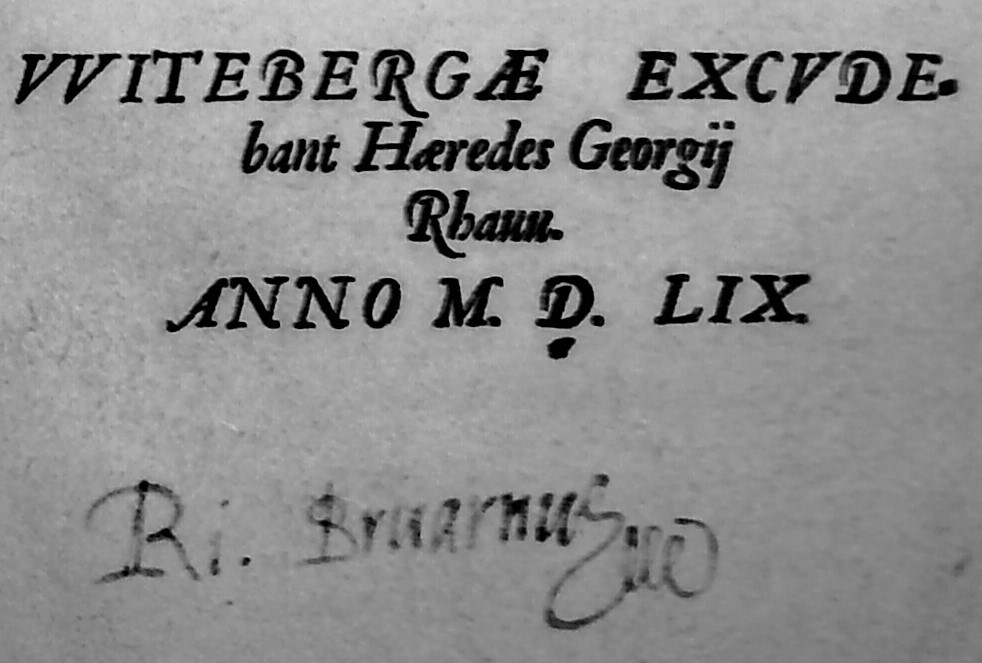
‘Ri. Bruarne’
Presumably the Richard Bruarne, who achieved a reputation as a Hebrew scholar, having been admitted to Lincoln College, Oxford, (c. 1535), graduating BA (1537), elected a Fellow (1538), and proceeding to MA (1539) and BD (1548). The same year he was elected a Fellow of Eton College, and appointed Regius Professor of Hebrew at Oxford until he was forced to resign his chair in 1559. A Catholic in outlook, Bruarne gave evidence in support of Stephen Gardiner at his trial in 1551, replaced Peter Martyr Vermigli as a canon of Christ Church, following the removal of the former in 1553, and was one of twelve Oxford and Cambridge theologians present at the Oxford disputations in 1554 when Cranmer, Latimer and Ridley were judged guilty of heresy, being rewarded soon after with a canonry at Windsor. In 1561, the fellows of Eton elected him Provost (without seeking the Queen’s permission) and after an investigation by Parker, Robert Horne and Sir Anthony Cook as visitors, he was forced to resign. He died in 1565 and was buried at Windsor. ODNB.
Brynckley [Brinkley], Richard.
See also Cambridge, Franciscan Convent
| 1521 | Pelbárt, O. | P15 | M.1.27 | RL |

‘Fratris Richardi Brynickilij [sic] ministri’ [erased]
Evidently the Cambridge Franciscan Richard Brynckley [Brinkley] who commenced BD 1489 and DD 1492, incorporated at Oxford in 1524, as Provincial Minister of the Order (1518-1526), dying c. 1525-1527. A student of Greek and Hebrew, he owned or borrowed a number of books of which some, like this, remain (J.R.H. Moorman, The Grey Friars in Cambridge 1225-1538, Cambridge: University Press, 1952, pp. 155f.; Ker, MLGB, 24, 401); Cooper I, 34.
Bullore or Bulloke, [?R. R.]
| 1507 | Castellensis, H. | C49 | H.1.21 | RL |
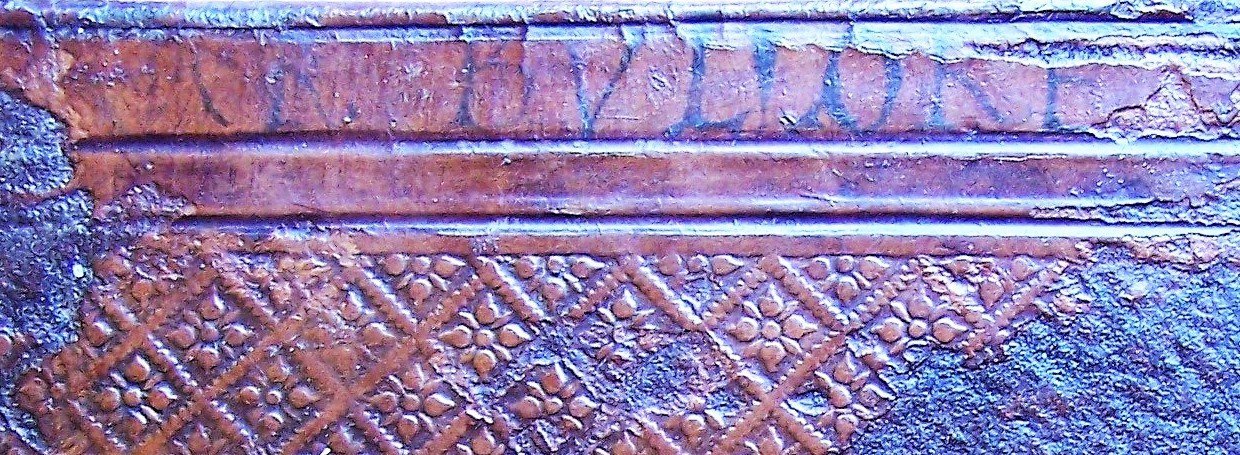
‘[?R.R.] Bullore’ or ‘Bulloke’ inscribed at top of front calf cover;
‘R.R’ very faded and uncertain.
Identification uncertain. A Richard Bullar, BA 1536/37, MA 1540, Fellow of Christ’s College 1539-1540, left (in 1540) a collection of 73 items comprising classical, grammatical and theological works including some of Erasmus, Melanchthon and Bullinger (BiCI, I, no.6), but not this one. If ‘Bulloke’, Venn records a Richard Bullock, BCanL 1476/77 but no other details; a Henry Bullock, Fellow of Queens 1506, DD 1520, author of Oratio habita Cantabrigiae (1520), Vice-Chancellor 1524-1525, friend and correspondent of Erasmus and chaplain to Cardinal Wolsey, who died in 1526; and a George Bullock, Fellow of St John’s College 1537/38, Master 1554-59, Lady Margaret Professor 1556-1559, DD 1557, who retired to Nevers Abbey, France, during the reigns of Edward VI and Elizabeth I, and later to Paris and Antwerp (died 1580).
Bulward, Thomas
| 1535 | Oecolampadius, J. | O10 | C.1.5 | RL [Garrett Godfrey] |

‘Thome Bulward p[re]tiu[m] iijs’
An older contemporary of Geste’s at King’s College, Cambridge, Thomas Bulward (or Burward) from Oxborough, Norfolk, was admitted as a scholar from Eton in 1525, graduated BA 1529/30 and MA 1533. He was a Fellow of King’s, 1528-1541.
Calvarde
| 1542 | Pighius, A. | P33 | N.4.6 | CT |
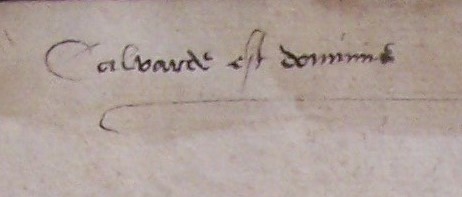
‘Calvarde est dominus’.
Venn records a John Calvard or Calver, at Queen’s College: BA 1526/27; MA 1530; Fellow of Queen’s 1529-1533; but nothing is recorded of his career after 1533. Venn also records a John Calvard: matric. pens. from St John’s, Michaelmas 1544.
| 1526 | Cochlaeus, J. | *C7 | H.1.19 | RL |

‘[?]Ego su[m] Jo. Calverdi ex dono mag[ist]ri J Fobson [=?Hobson] Vectensis’ [from the Isle of Wight]’
Possibly the same Calvarde. On ‘J Fobson’ [=?Hobson], s.v. ‘Hobson’, below.
Cambridge, Franciscan Convent.
See also Brynckley, Richard
| 1521 | Pelbárt, O. | P15 | M.1.27 | RL |

‘Thomas Potter’, ‘p[re]tium vj . 1565’
and (in an earlier hand – all erased) ‘Fratris Richardi Brynickilij [sic] ministri’.
The Cambridge Franciscans were dissolved in 1538. The identity of this Thomas Potter who acquired the book in 1565 has not been discovered.
Chedsey, William
| [c. 1545] | Postel, G. | P45 | ZC2.6.4 | PT |

‘Gulielmi Chedsei’
Presumably the William Chedsey, Canon of Christ Church, Oxford, and Catholic opponent of the Protestant Reformers. Admitted to Corpus Christi College, Oxford, 1529 from Somerset (aged 18); BA 1530; Fellow 1533; MA 1534; ordained priest 1535; chaplain to Edmund Bonner (1536); BD 1542; and DD 1546. Opposed Peter Martyr Vermigli, Regius Professor, at the Oxford Disputation on the eucharist (1549), committed to the Marshalsea for ‘seditious preaching’ in 1551 and then entrusted to Thomas Thirlby, bishop of Ely, for the rest of Edward’s reign. With Mary’s accession, preferment followed, with prebendal stalls at Windsor (1554), St Paul’s, Exeter and Oxford (1557), and in 1558 he became President of his college. In 1554, he took part in the Oxford disputation on the eucharist against Cranmer, Ridley and Latimer. Under Elizabeth I, he lost all his preferments and was imprisoned in the Fleet as a recusant (1562), dying in custody (c. 1577).
D., T.
| 1544 | Chiari, Isidore | C64 | C.3.12 | CT |
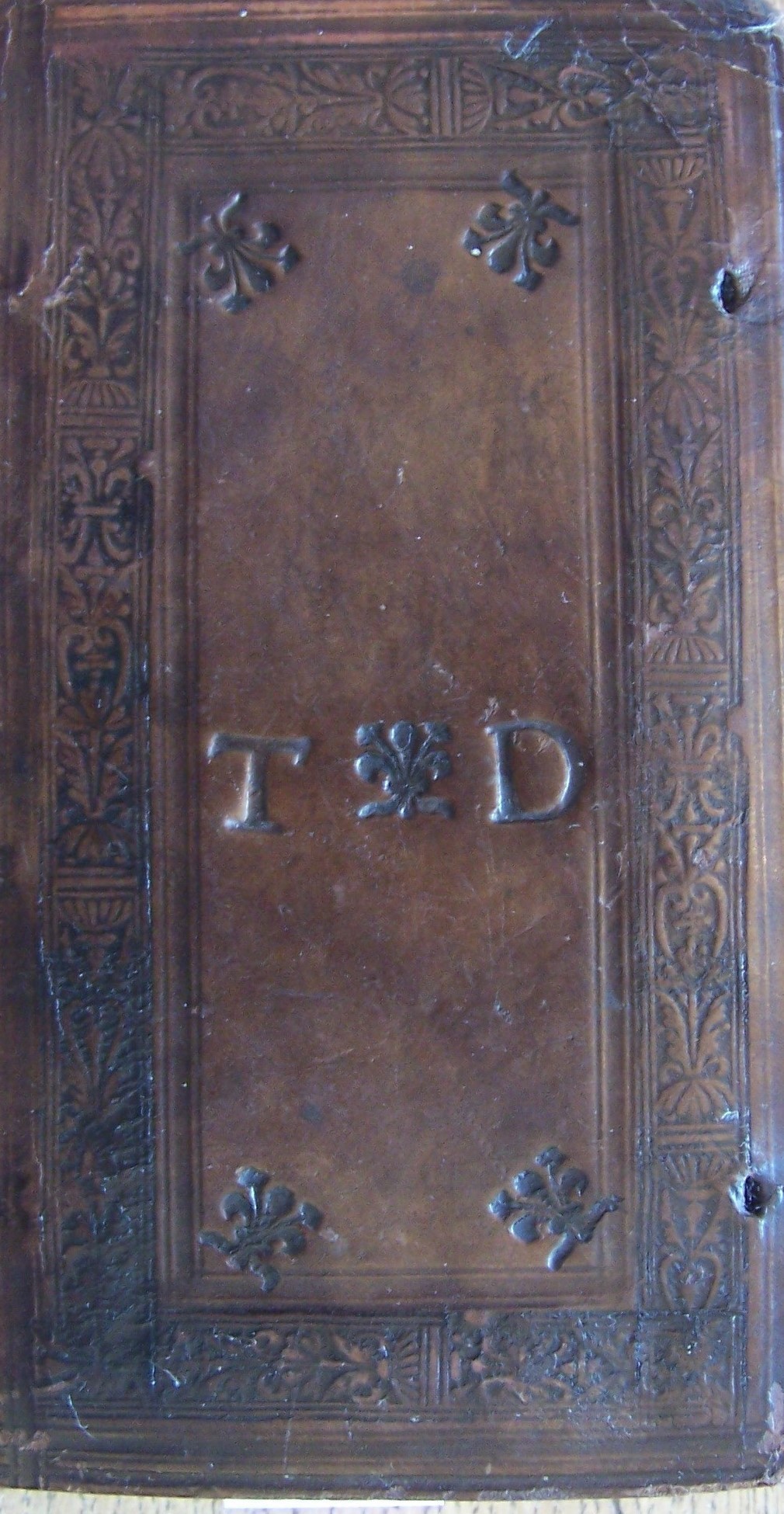
‘T D’ on covers astride centre tool CT c.1 on calf covers.
Identity uncertain.
Venn records a Thomas Dickenson who was admitted to King’s College, Cambridge, as a scholar from Eton in 1522. BA 1526/27; MA 1530/31. One with this name was rector of St Mary, Colchester, Essex, 1556-1558, died in 1558.
Dixon
| 1523 | Erasmus, D. | E28 | G.5.20 | PNL [Nicholas Spierinck] |
.jpg)
‘Geste me possidet
teste Dixono [?] et Hoasone [? = Ha[n]sone]
dixione’.
Venn records a Richard Dixon admitted to King’s as a scholar from Eton in 1551.
On ‘Hansone’ etc., see under ‘Hoasone‘ (Hanson) below.
Dunwich, William
| 1533 | Haymo | H9 | D.5.13 | PNL [‘I G’] |
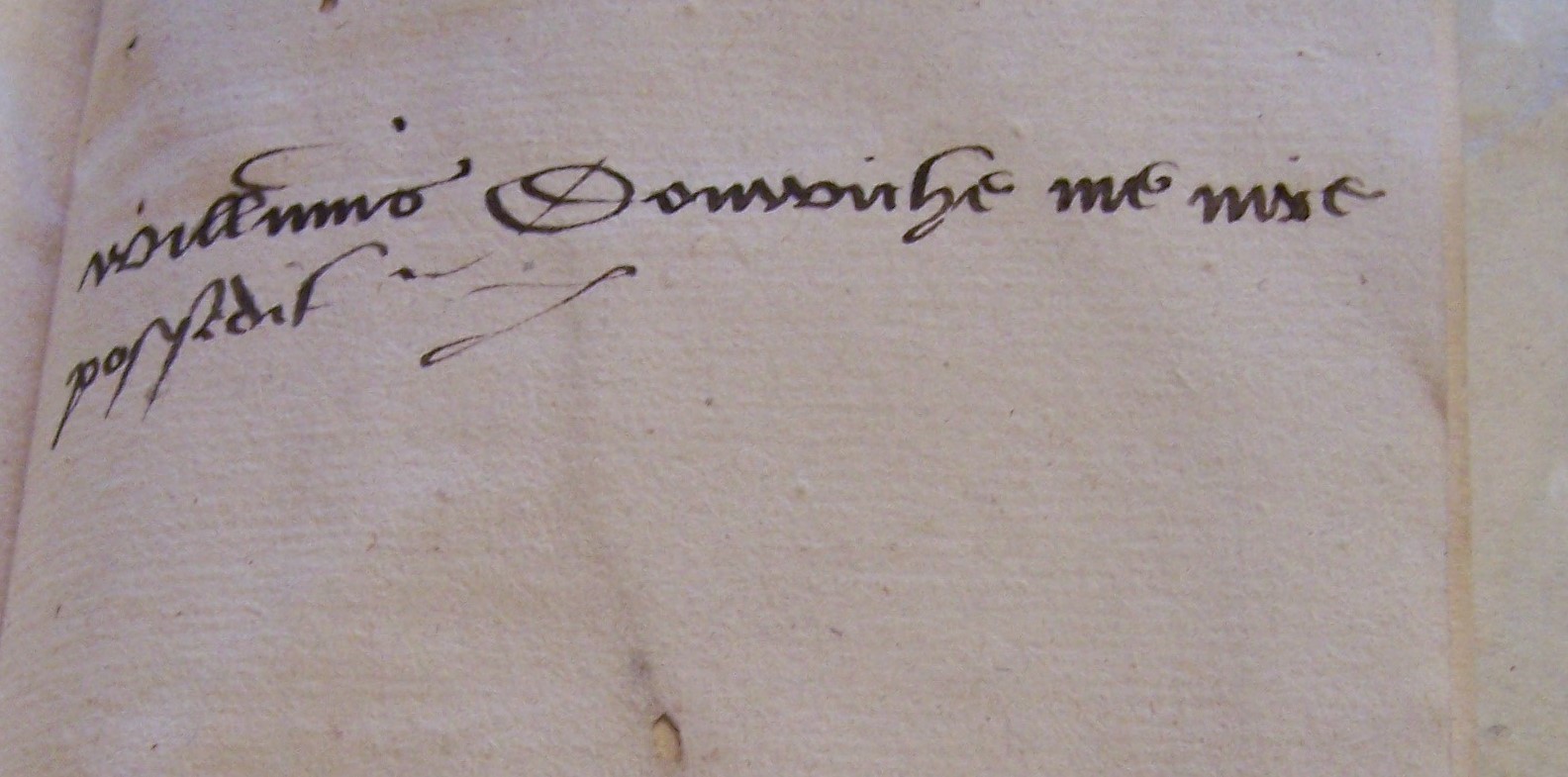
‘Will[iel]m[u]s Donwiche me iure possedit’ on the last blank leaf (Ddd8) in an early sixteenth-century hand.
I owe this transcription to Dr. E. Leedham-Green. Unidentified.
Edington, Wiltshire – House of Bonshommes, of St James, St Catherine and All Saints
| 1478 | Gulielmus, Parisiensis | G49 | L.5.10 | R |

‘Liber domus de Edyndon’.
The house was dissolved when the rector and twelve ministers surrendered in 1539. Ker, MLGB, 77, 401; Knowles, MRH, 179.
G., I.
| 1556 | Euthymius. | E59 | A.6.25 | CT |
‘I G’ on covers.
Unidentified.
Geste, Edmund
| 1495 | Ficino, M. | F5† | Z.2.56 | R |
‘J. Bransbei
Gest’
| 1523 | Erasmus, D. | E28 | G.5.20 | PNL [Nicholas Spierinck] |
‘Geste me possidet
teste Dixono [?] et Hoasone [? = Ha[n]sone]
dixione’.
‘[???] me possidet’
‘me possidet Edmundus Gest’
| 1524 | Clichtoveus, J. | C82?‡ | N.3.17 | RL |
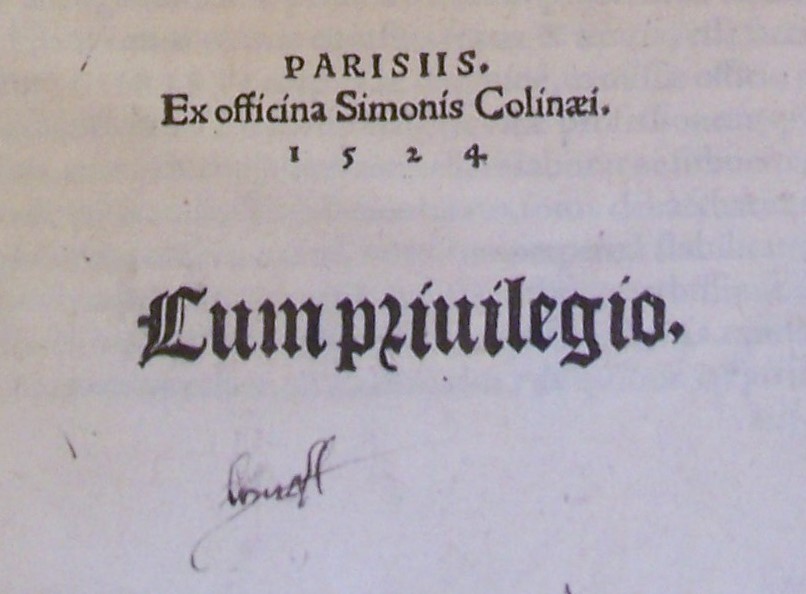
?’Guest’.
| [?1525] | Bugenhagen, J. | B116 | C.5.11(b) | R |
‘gest’
| 1525 | Capito, W. F. | C39 | F.2.4 | PT |
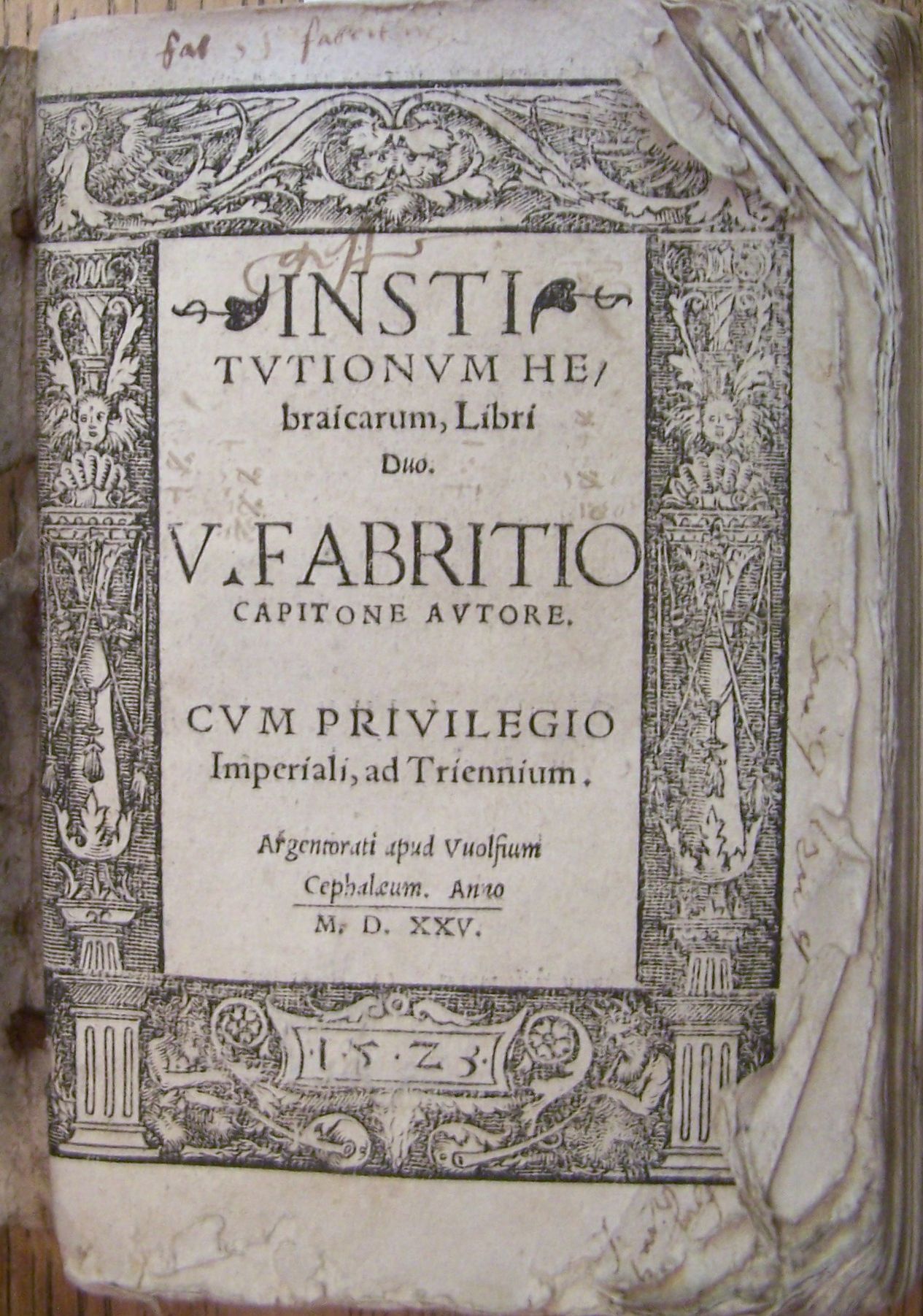
‘Gest’

‘Geste me possidet teste scriptor[e]’.
| 1525 | Knopken, A. | K11 | D.2.6(b) | RL |
‘gest’
| ?1525 | Zwingli, U. | Z6 | N.6.13 | RL |
‘gest’
| 1526 | Bugenhagen, J. | B113?† | C.5.4(f) | RL/CT |
‘gest’
| 1526 | Erasmus, D. | E40?‡ | L.6.4 | R |
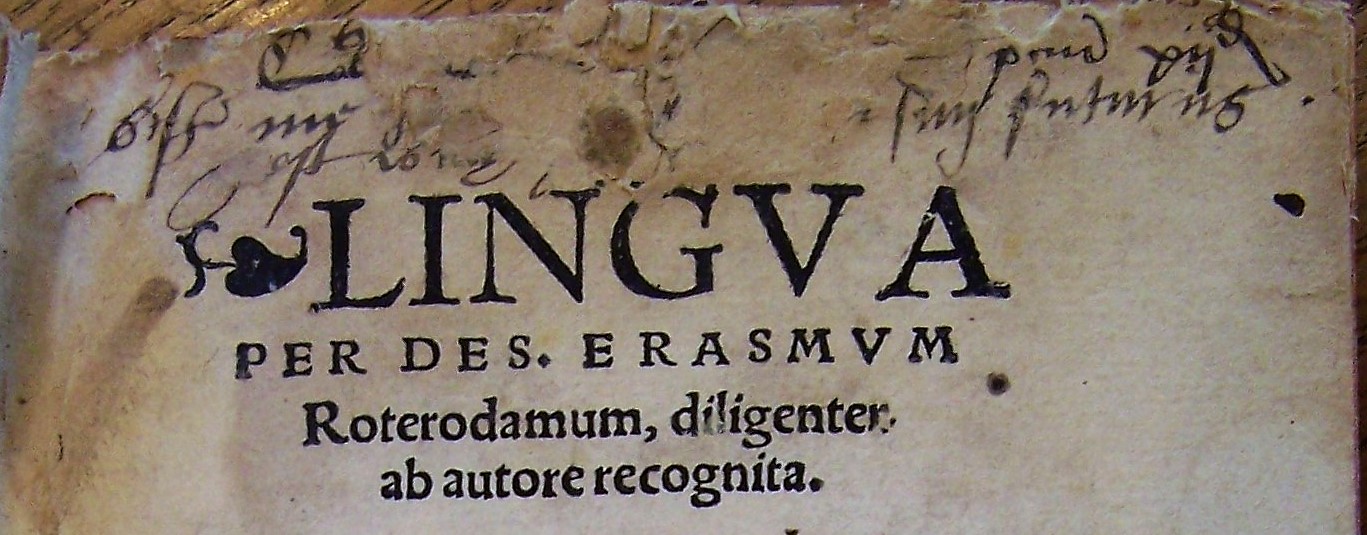
‘Gest me p[ossidet]?’ ??
| 1527 | Bucer, M. | B102‡ | C.1.6(c) | RL |
‘gest’
| 1527 | Erasmus, D. | E48† | H.1.2 | PNL |
‘Joa[n]nis Brandesbie
Sum liber Gest ex dono doctoris Bra[n]desbei’
‘caput’ …
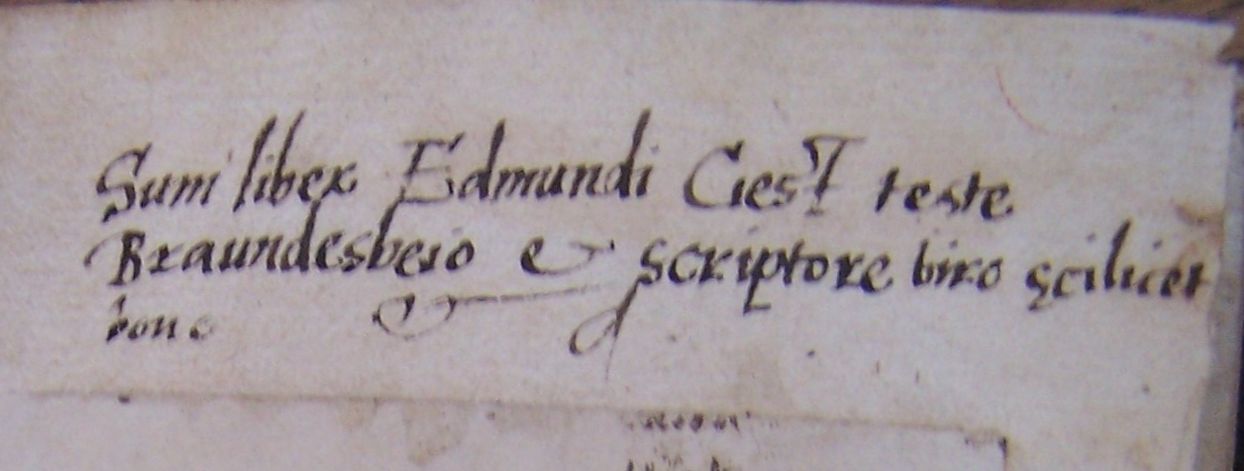
‘Sum liber Edmundi Gest teste
Braundesbeio e scriptore ?viro scilicet
bono’
| 1527 | Vio, T. de | V33?‡ | K.3.42 | PL |
‘gest’
| 1528 | Althamer, A. | A26 | D.2.6(d) | RL |
‘gest’*
| 1528 | Melanchthon, P. | M46?† | C.5.4(e) | RL/CT |
‘gest’
| 1532 | Sachs, H. | S2 | ZC2.7.9(a) | R |
‘Ed. Gestus me possidet testante scriptore’.
| 1532 | Erasmus, D. | E33 | I.3.8 | CT |
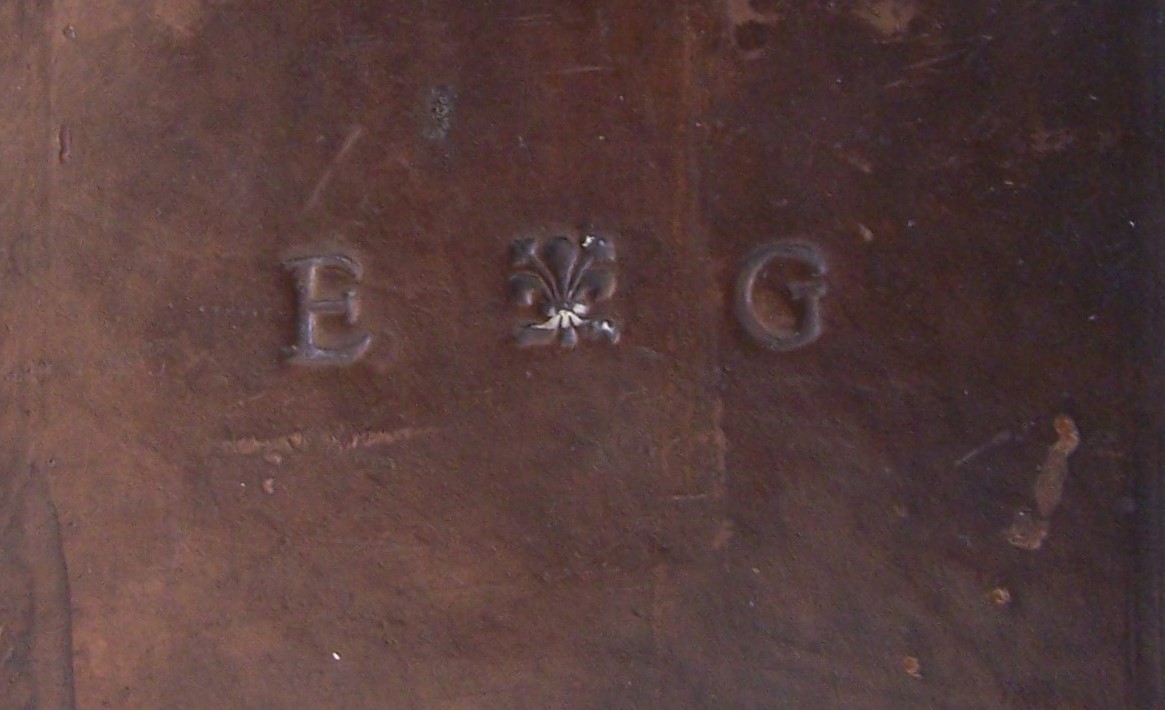
‘E G’ on covers.
| 1534 | Erasmus, D. | E38 | ZC1.4.6 | CT |
‘E G’ on covers.
| 1534 | Oecolampadius, J. | O15‡ | C.1.6(b) | RL |
‘gest’
| 1536 | Megander, C. | M26 | D.2.6(c) | RL |
‘gest’*
| 1537 | Suetonius | S96 | Y.5.29 | RL |

‘Su[m] liber gest’.
| 1538 | Luther, M. | L63 | D.5.4(a) | RL |
‘gest’
| 1538 | Luther, M. | L72 | ZC2.6.14† | PT |
‘good maister Brandes[by] accept my wytt’.
| 1538 | Draconites, J. | D25?† | C.5.4(c) | RL |
‘gest’
| 1539 | Campensis, J. | C29 | F.2.5 | PT |
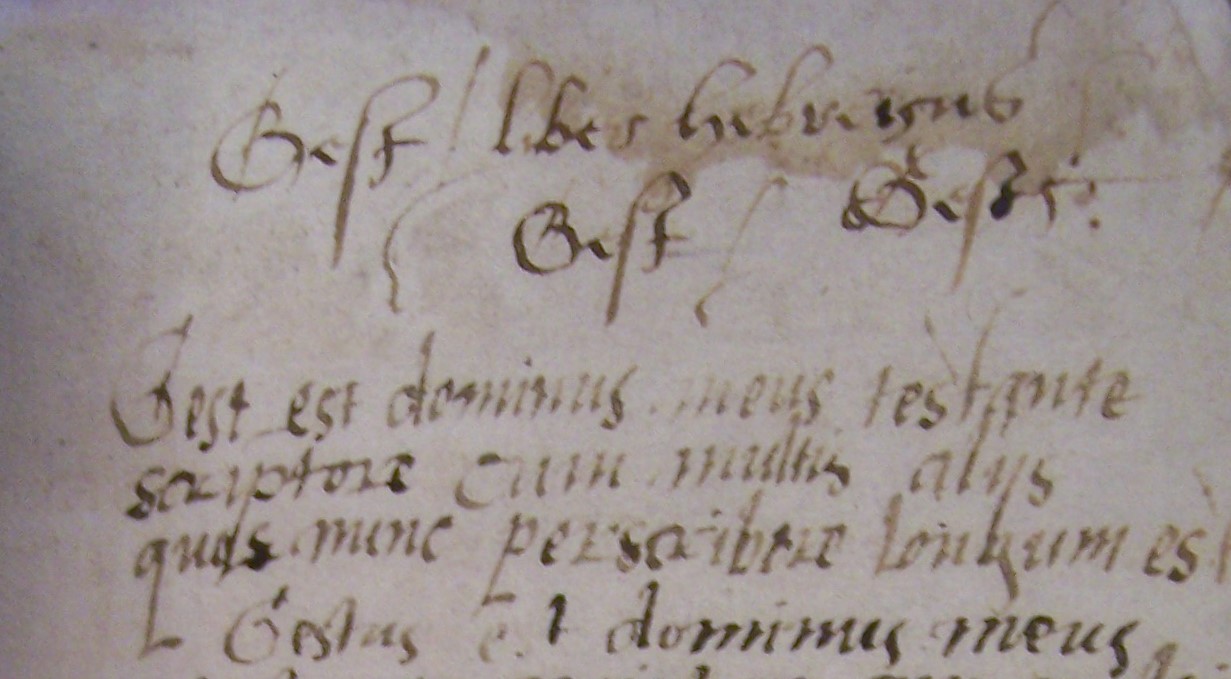
‘Gest / Liber hebraicus
Gest / Gest[?]e.
Gest est dominus meus testante
scriptore cum multis alijs
quas nunc perscribere longum est.
Gestus est dominus meus testante
scriptore cum multis alijs’.
| 1543 | Rhegius, U. | R20 | C.6.5(c) | PL |
‘Mr gest’
| 1544 | Brentz, J. | B89 | C.6.5(a) | PL |
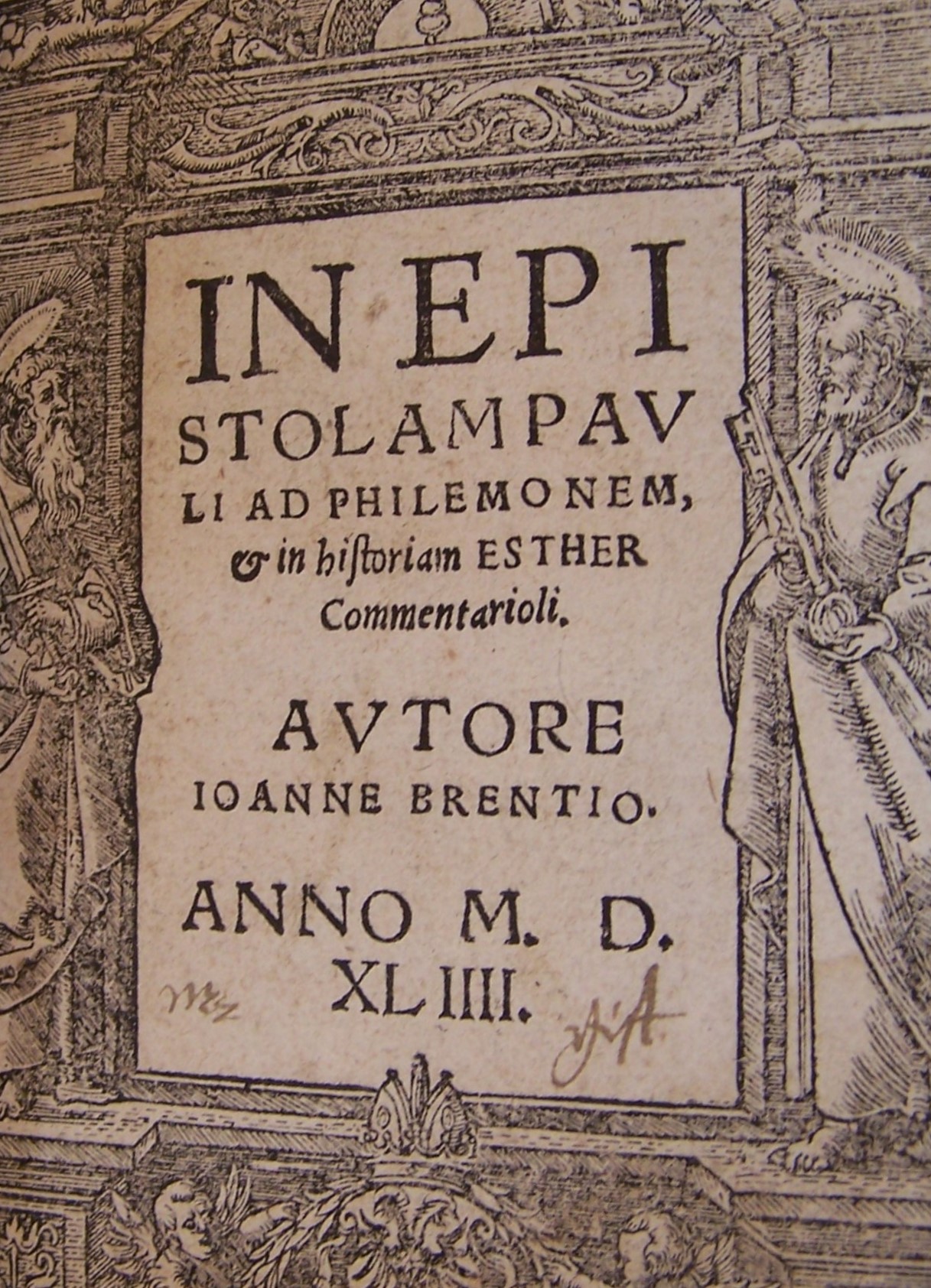
‘[?]Mr gest’
| 1544 | Aepinus, J. | A6 | C.6.5(b) | PL |
‘[?]Mr gest’
| 1544 | Sarcerius, E. | S21 | D.6.8 | RL/CT |
‘gest’*
| 1546 | Cruciger, C. | C114 | D.4.4 | CT |
‘g’ [for ‘gest’?]
| 1546 | Spangenberg, J. | S77 | G.6.23 | MS |
‘m[r] gest[?e]’
| 1549 | Flacius, M. | F12 | ZC2.8.10(b) | R |
‘gest’
| 1550 | Meier, G. | M41 | ZC2.8.10(a) | R |
[?]’gest’*
| 1550/1 (10 Feb.) | Eucherius | E55 | E.4.1 | RL |

Presentation inscription ‘to Mr Edmunde Gest’ from Christopher Leedes.
| 1550/1 (10 Feb.) | John, of Damascus | J12 | N.3.13 | RL |
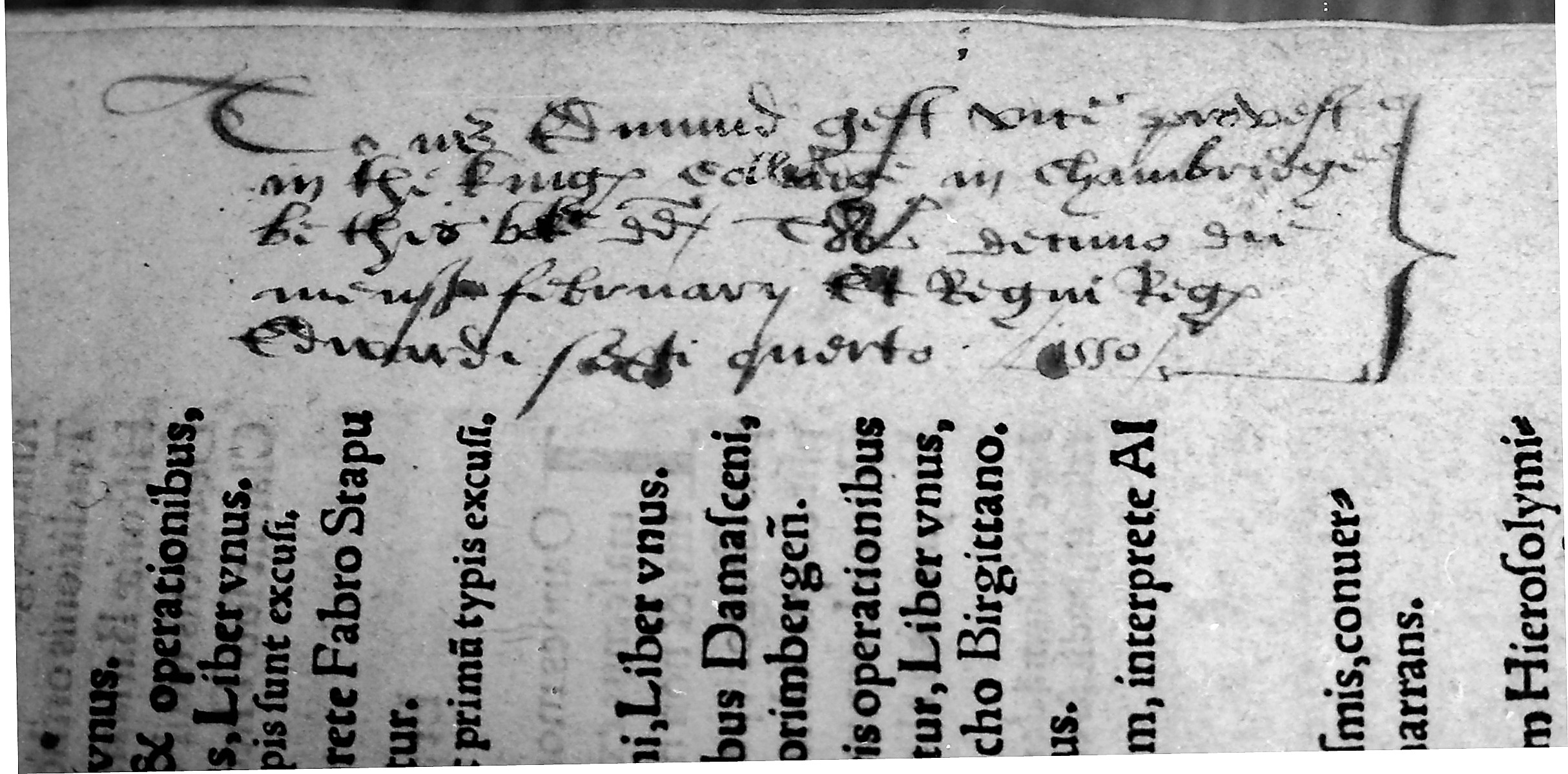
Presentation inscription ‘to Mr Edmund gest’ from Christopher Leedes.
| [?1551] | Bullinger, H. | B122 | G.3.22 | R |
Presentation inscription to ‘Mr Edmund Geste’ from Christopher Leedes.
| 1553 | Zegers, N. | Z3 | E.6.30 | PT |

‘Edmond | Roffen’
| 1555 | Borrhaus, M. | B59 | G.4.10(a) | R |
‘E. Gest’.
| 1557 | Borrhaus, M. | B60 | G.4.10(b) | R |
‘E. Gest’.
Gilpin, [?Godfrey]
| 1539 | Bonaventura | B52 | C.4.1 | R |

[?]’D. gilpinnus’ at top of tp (erased).
Identity uncertain.
A Godfrey Gilpin of Christ’s Cambridge, was later a Fellow of Trinity, Lady Margaret Preacher and (at the time of his death) Vice-Master of Trinity and vicar of Pinchbeck, Lincs. An inventory of his books (made 13 September 1550) lists mainly theological works (BiCI, I, no. 46), though this is not among them. Venn.
Gwyn, William
| 1522 | Henry VIII | H40 | N.5.13(a) | PNL |

‘iste liber co[n]stat Will[ielm]us Gwyne’.
| 1523 | More, T. | M81 | N.5.13(d) | PNL |
 final leaf - 'Iste liber constat Will[ielm]us Gwyn'.jpg)
On final leaf of associated item (d): ‘Iste liber constat Will[ielm]us Gwyn’.
Identity uncertain.
A William Gwyn was Rector or Prebend (second portion) of St George’s, Pontesbury, Shropshire (in the gift of The Queen’s College, Oxford ) from 1529-1540, and a William Gwyn held office at the Hospital or free Chapel of St Nicholas, Nantwich, Cheshire, presented in 1531, and held the Prebendal stall of Stotfold, Lichfield Cathedral.
Gylbe[rt], Thomas
| 1546 | Smith, R. | S64 | R.6.46 | CT |
Part of a leaf of a MS letter (in English) from ‘Thomas Gylbe[rt]’, dated from London, 21 July 1561.
Identity uncertain.
A Thomas Gylbert was a Fellow of Peterhouse, Cambridge, 1521–1526, but Venn records no further details after 1526, and there is no particular reason to associate this Gylbert with Cambridge since by the time the book was bound Geste had left Cambridge and was purchasing his books in London. Furthermore, as the letter was binder’s waste there is no reason to suppose that Gylbert had ever been the owner of the book.
Hoasone[?]
| 1523 | Erasmus, D. | E28 | G.5.20 | PNL [Nicholas Spierinck] |
‘Geste me possidet
teste Dixono [?] et Hoasone
[? = ‘Ha[n]sone’, though ‘Hoosone’ and even ‘Howsone’ have been suggested].
Identity uncertain.
Venn records only a Thomas Hanson (alias Hampson) with a BA 1524/25, Cambridge college not known. See also under ‘Dixon’ (above).
Hobson[?]
| 1526 | Cochlaeus, J. | *C7 | H.1.19 | RL [‘M D’] |

‘[?]Ego su[m] Jo. Calverdi ex dono mag[ist]ri Hobson[?] vectensis’ [= of the Isle of Wight].
Identity uncertain.
Venn records three Hobsons who held the degree of MA. A ‘Richard’ (college unknown), MA 1520/21, BD 1528 and DD 1530 who has been identified with the ‘Richard’ in Cooper, I, 69; a ‘Robert’, MA and Fellow of St John’s (1533), who may have been the one who later held livings in Yorkshire (1551-1570); and a Hobson (Christian name not recorded), MA 1517, BD 1527, who may have been a Fellow of Clare College. See also under Calvarde.
Holcot, William
| 1559 | Bible. Latin. [ed. Castellion.] | B35.5 | E.1.15 | R |
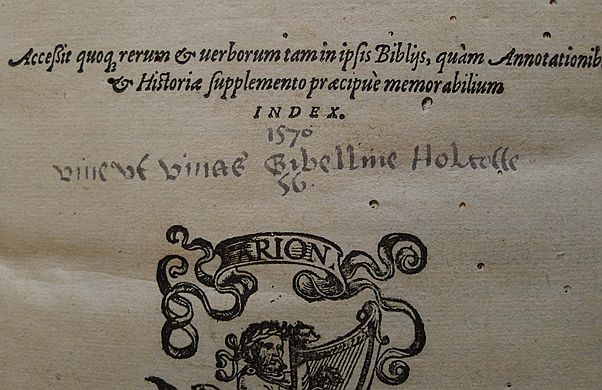
‘1570 | viue ut viuas Gibelline Holcotte | 56’
William Holcot [Holcott or Holcotte] (c1514–1575), the donor of this Latin Bible, was a gentleman and book collector, the last of the Holcots who had lived as Lords of Barcote Manor in the parish of Buckland, Berkshire, since the thirteenth century. Little is recorded of his early life, though he resided, perhaps as an undergraduate commoner, at University College and The Queen’s College, Oxford, at different times without matriculating or graduating. John Foxe in his Actes and Monuments (1563, 1868 ed. vol VIII.2, p.708f.), records how in 1554, while ‘a sojourner’ at University College Oxford, he attempted to secrete a copy of Stephen Gardiner’s A detection of the Devils Sophistry (1546) from his study to Thomas Cranmer, interred in the Bocardo Prison, at the time of the Oxford Disputation on the eucharist (1554), only to be apprehended by the bailiffs and forced by Dr Weston under pain of treason and expulsion from his college to subscribe to the same three articles in dispute. Holcot, a Protestant, subsequently repented of his action and became a lay preacher in Elizabeth’s reign, reputedly mounting the pulpit dressed in a damask gown and velvet bonnet, sometimes adding a gold chain. In a lengthy and eccentrically worded Will (1575), he left books to University College (six of which are listed in a later benefactors register of 1674) and to The Queen’s College, Oxford, at least three of which have been identified in the former, as well as giving money to be used to pay for battels for a poor scholar. He also expressed his wish to be buried in St Mary’s, Buckland, along with his ancestors, though he actually died in London, his heart being buried in a triangular locker in the chancel of St Mary’s, Buckland.
Image of the Holcot provenance inscription kindly supplied by Salisbury Cathedral Library, with permission for its reproduction here. The same provenance inscription occurs in the University College Oxford copy of Robertus Holcot, Quaestiones super IV libros Sententiarum, at present in the Bodleian Library, see A Catalogue of Books Printed in the Fifteenth Century now in the Bodleian Library, Oxford (now Bod-Inc online), H-129, Second copy, pp.1346-47. Additional information kindly provided by Professor John Craig (Simon Fraser University, Burnaby, BC Canada), and Dr Darwall-Smith (Archivist, University College, Oxford). See also Buckland Living History and Guide to the Church of St Mary Buckland, 3rd ed. 2012 (websites).
J., D.
| 1527 | Herodotus | *H2 | Y.3.19(a) | RL |
.jpg)
‘D: J'[… smudged] on p. 11.
Not identified.
See also under Williu[m] or Welliu[?m], Thomas.
Joy[?], Hugh[?]
| 1527 | Thucydides | *T3 | Y.3.19(c) | RL |
.jpg)
 This is the book....[cut off].jpg)
‘This is the book [?of] Hue [?] Joyyees’, in the hand of a young sixteenth-century reader, on p. 24 and on p. 126 (where the name has been torn off ).
But it may not be a name at all: ‘This is the booke true Joyyees’
Not identified.
See also Newton.
K., H.
| 1566 | Nowell, A. | N14 | O.1.16 | PT |

‘H.K.’ stamped in gold on both covers.
Not identified.
Venn records a Hugh Kebyll, Fellow of Peterhouse, 1529; BA 1526/27. The grace for MA 1530 has been erased. No further details. A Henry Kempe was admitted as a scholar from Eton, 22 August 1551, matriculating the same year but leaving in 1555. See also under Appleby, John.
Kervyle, Nicholas
| 1536 | Brentz, J. | B72 | C.6.1 | PNL |
‘Qui stat videat ne cadat’ [Let him who stands take care not to fall.]
‘Kervyle’.
| 1541 | Sarcerius, E. | S17 | C.6.10 | RL |
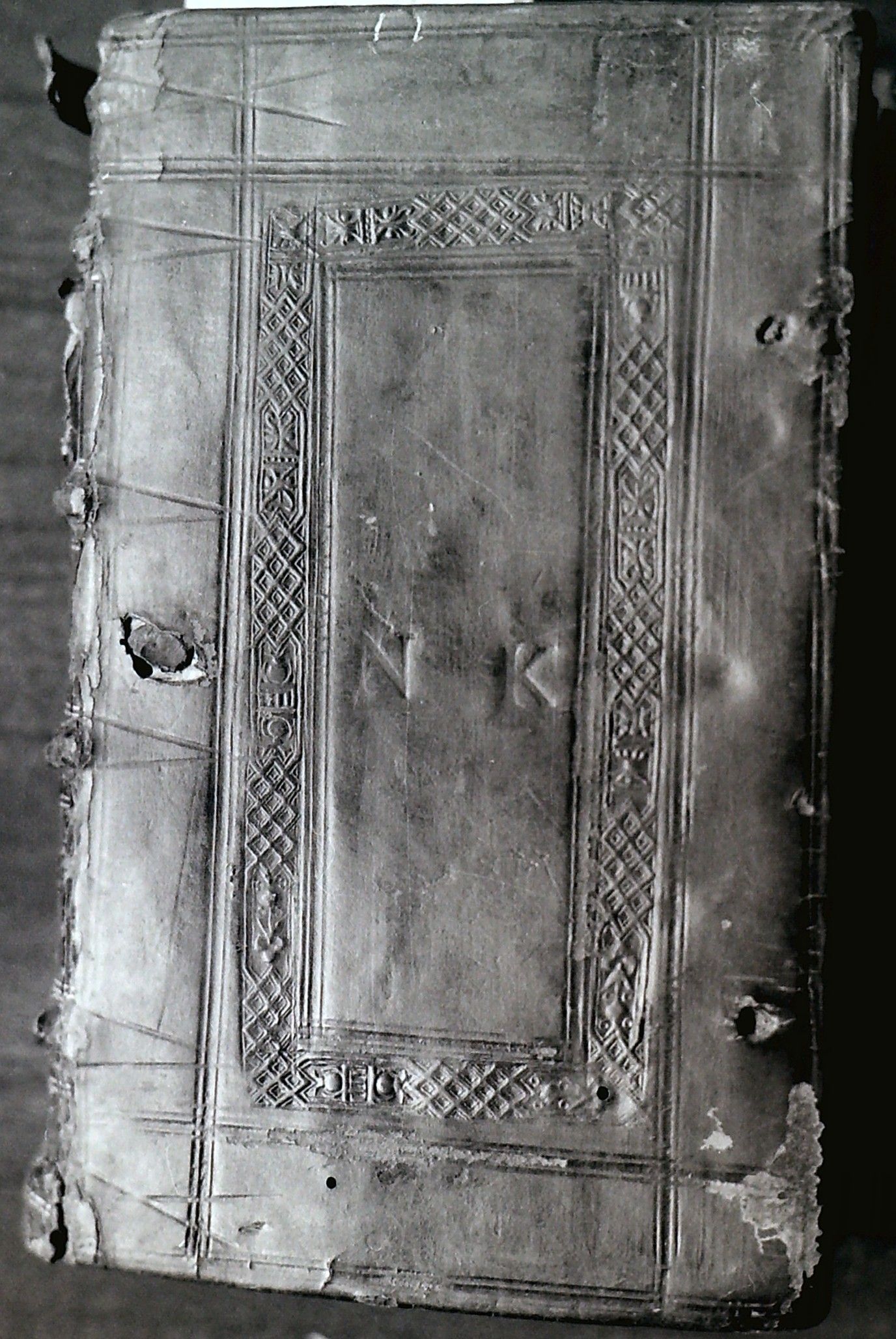
‘N K’ stamped in blind on the covers
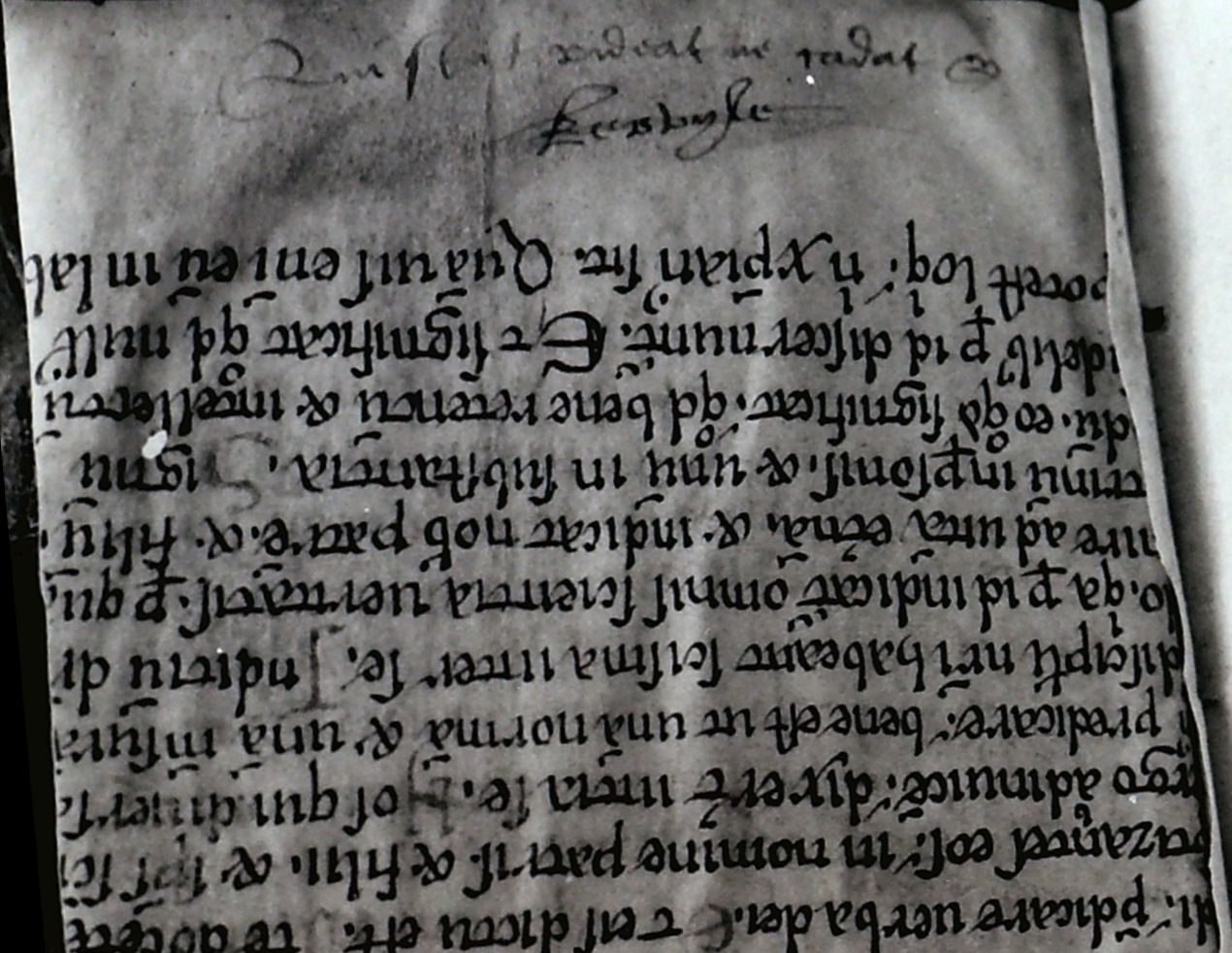
‘Qui stat videat ne cadat [ex?] Kervyle’
A younger contemporary of Geste who entered King’s College, Cambridge, in 1545 as a scholar from Eton (aged 17); a Fellow from 1548, he graduated BA in 1550, proceeded to MA in 1553, and then went into exile on the continent, first at Zürich (in the house of the printer Christopher Froschauer), then at Frankfurt. On return, he became chaplain to Edmund Grindal, Bishop of London, and in 1560 vicar of South Weald, Essex, to which was added later that year the nearby rectory of Laindon, holding both livings until his death in August 1566. The previous year he had been among the leading opponents of the prescribed clerical vesture, along with Thomas Sampson and Laurence Humphrey, petitioning the ecclesiastical commission for exemption and one of the five who formally presented the petition to Matthew Parker, archbishop of Canterbury. Venn; ODNB.
Kyrbe, Chrysostom
| 1512 | John, of Damascus | J13 | L.4.5 | R |
‘Chr[i]so[s]to[?mus] Kyrbe canonicu[s] de Welbeke’.
Possibly one of the canons of the Premonstratensian Abbey of St James, Welbeck, Notts., but not among the canons granted pensions who signed the surrender in 1538 – but he may have been one of the three who were residing on their vicarage or grange at the time of the surrender but still granted a pension, or he may have died before the surrender. Apparently not recorded in Ker, MLGB or Ker-Watson, MLGB Suppl.
Langrige, Richard
| 1523 | Gregory I | G31 | A.1.15 | R |
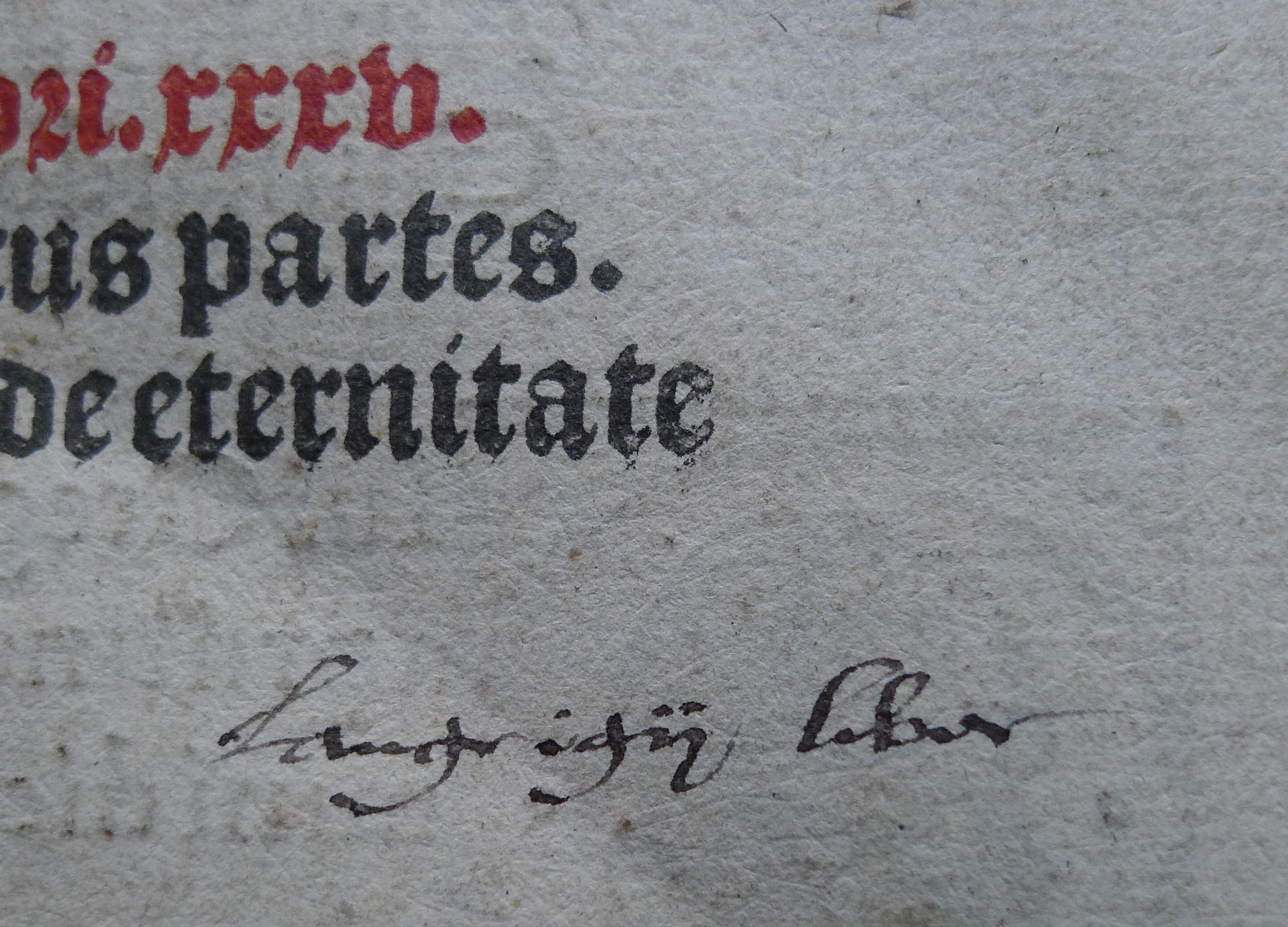
‘Langrigii liber’.
Possibly the Dr Richard Langrige, STP, who was archdeacon of Cleveland and (like John Brandisby) chaplain to Edward [Lee], Archbishop of York, and involved in securing signatures for the Royal Supremacy in 1535.
Lee, Edward
| 1503 | Petrus, Comestor | P20 | L.4.10 | R |
‘Edoardus leeus london’.
‘liber Edoardi leej’.
Both on a flyleaf at the end.
Presumably the Edward Lee (1481/2-1544) who was archbishop of York (1531-1544) in succession to Thomas Wolsey. John Brandisby and Richard Langrige were among his chaplains. Admitted to Magdalen College, Oxford, in 1495, Fellow (1500), graduated BA 1501, Lee migrated to Cambridge, incorporating his degree (1503), being ordained in the London diocese (1504) and acquiring a number of preferments including prebendal stalls at Exeter, Lincoln, and Salisbury (1509-1531). After proceeding to BD 1515, Lee moved to the continent for further study at Louvain and Bologna (later incorporating a DTh at Oxford in 1531), assisting Erasmus in his revision of the NT, but soon clashing with him by publishing his own emendations, annotations and apologia (1520-1521), copies of which Geste owned (L26). Appointed chaplain and almoner to Henry VIII (1523), Lee was sent on a number of embassies, including one to the pope at Bologna (1530), and was rewarded with the chancellorship of Salisbury (1529) and prebendal stalls at St Stephen, Westminster (1530) and York (1531), becoming its archbishop (1531-1544), during which time he attempted to balance his conservative instincts with loyalty to Henry VIII. Emden; Foster; ODNB.
Lee, Richard
| 1559 | Loss, L. | L41 | G.2.15 | R |

‘Ricardi Lei et amicorum’ [deleted].
Among a number of this name, Venn records a Richard Lee who was Fellow of St John’s, 1516, MA 1517, but no further information. See also Philpot, J., whose name occurs on the same tp.
Leedes, Christopher
| 1550/1 (10 Feb.) | Eucherius | E55 | E.4.1 | RL |

‘C L’ monogram.
Presentation ‘to Mr Edmunde Gest’ written down the outside margin of tp.
| 1550/1 (10 Feb.) | John, of Damascus | J12 | N.3.13 | RL |

‘C L’ monogram.
Presentation to ‘Mr Edmund gest’ written as above.
| [?1551] | Bullinger, H. | B122 | G.3.22 | R |
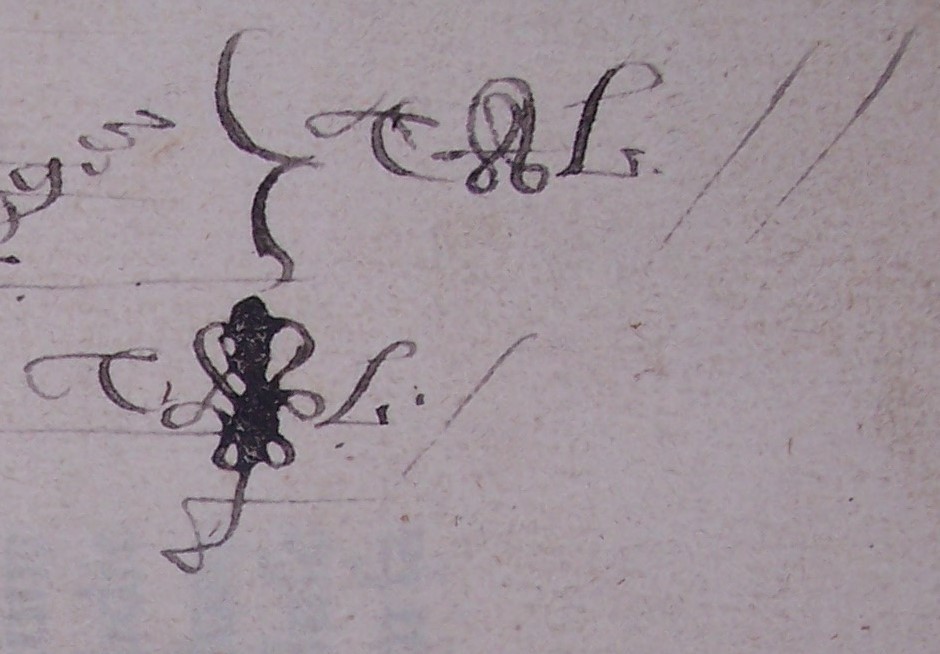
‘C L’ monogram.
Presentation to ‘Mr Edmund Geste’ written as above.
Nephew of John Brandisby and Geste’s brother [in-law]. See Introduction.
Lodyngton, Joannes
| 1518 | Le Fèvre, J. | L25 | L.5.36 | RL |
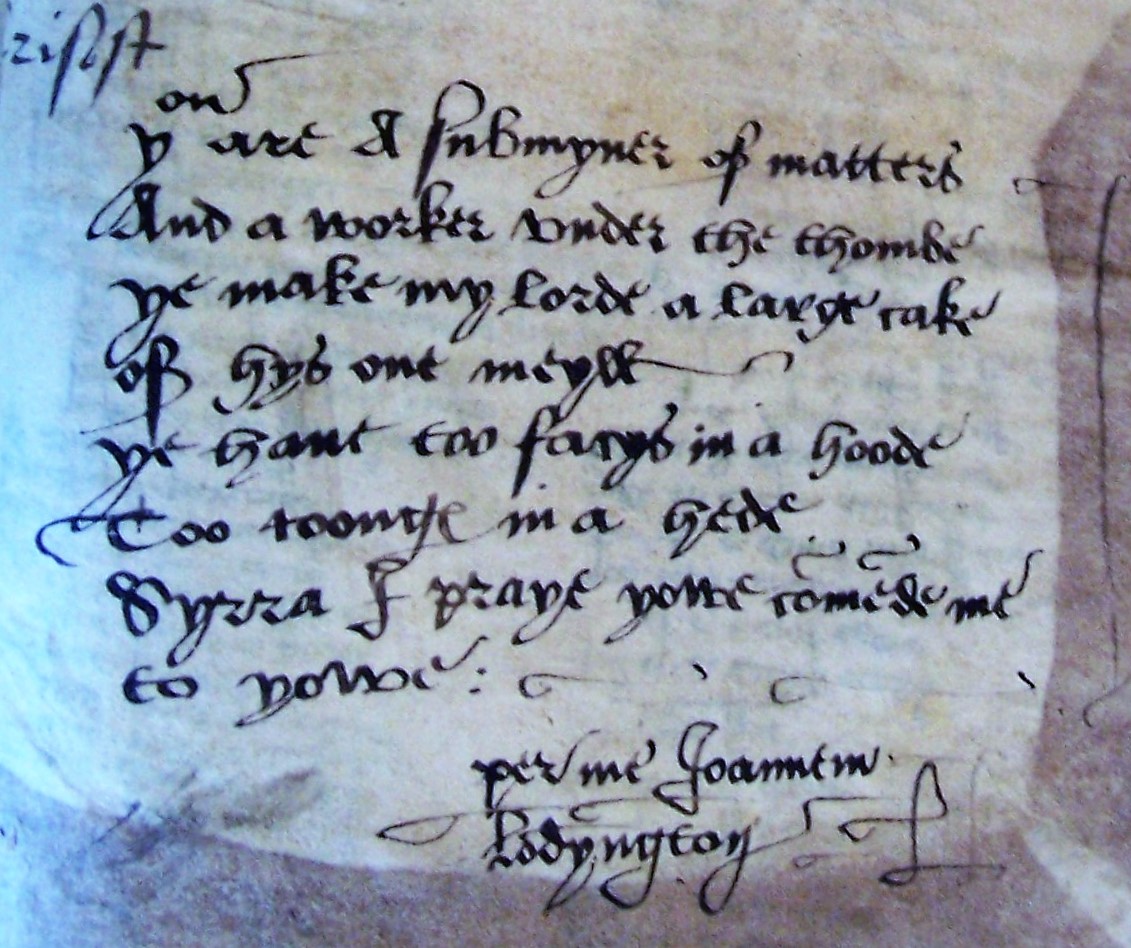
Verse at end of MS flyleaf, signed ‘per me Joannem Lodyngton’.
A John Lodyngton, cellarer, alias Atkyns, was the third among fourteen canons from Launde Augustinian priory of St John the Baptist in Leicestershire who acknowledged the Royal Supremacy in 1534 (L. & P., VII (1534), no. 1126), third among thirteen from the same priory petitioning Thomas Cromwell for pensions in c. 22 December 1538 (L. & P., XIII.ii (1538), no. 1123), and, as John Atkyns, was among eleven (from the dissolved priory) granted a pension (of £8 p.a.) on 16 December 1539, L. & P., XIV.ii. (1539), no. 692.
Mabliston[e], John
| 1544 | Broeckwey a Konigstein, A. | B94 | D.4.8 | RL/CT |

‘Joannes Mablistonus’ across tp.
Not identified.
Maxfeldus, Thomas
| 1539 | Bonaventura | B52 | C.4.1 | R |
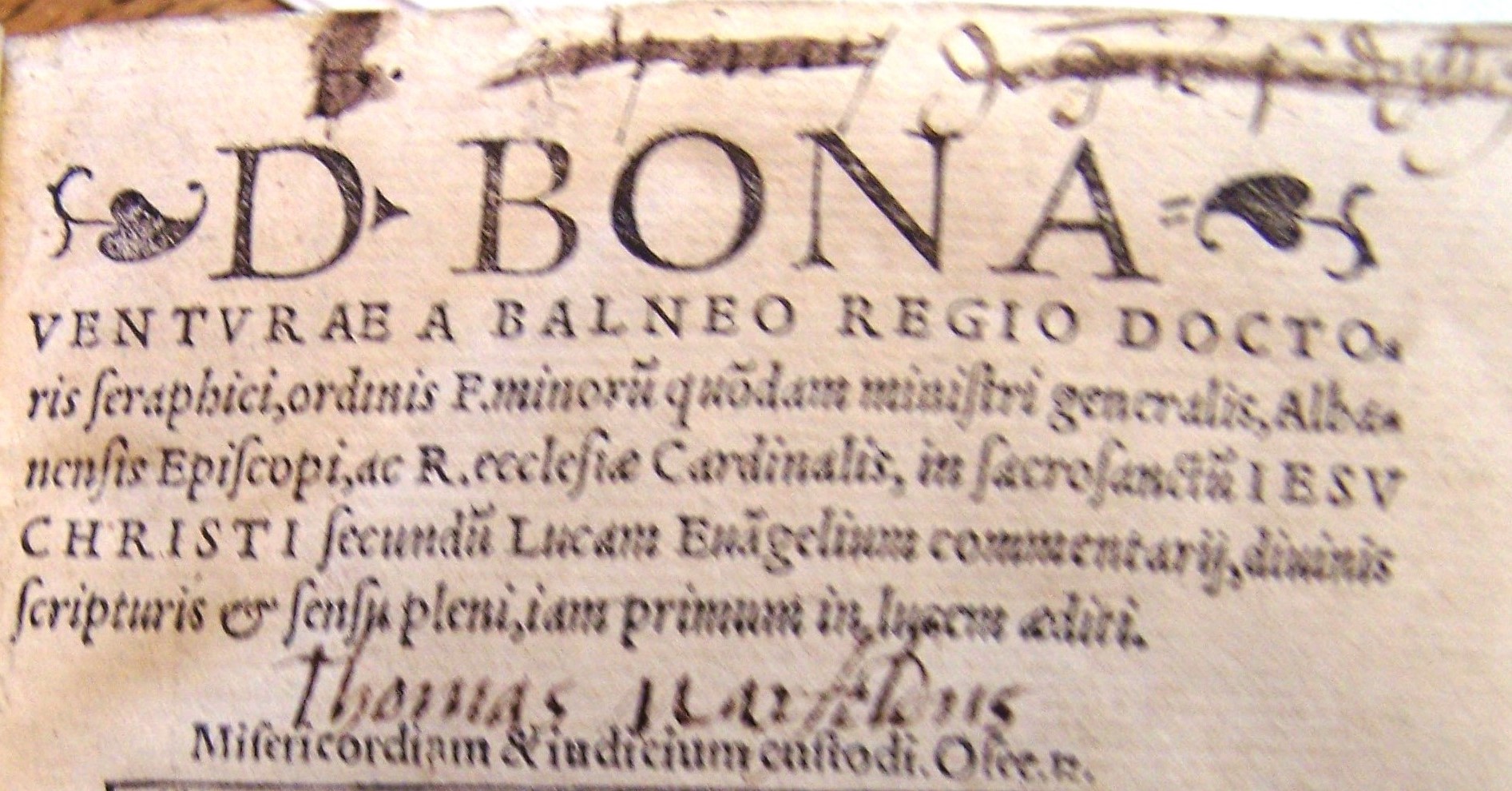
‘Thomas Maxfeldus’ on tp.
A ‘Thomas Maxfield’ (as Dr E. Leedham-Green informs me) is recorded in Venn as BA from Magdalene in 1575/76, but it is far from certain that this is the one whose inscription occurs here, not least because of its late date.
Two other ownership inscriptions on tp. (both erased).
See under Gilpin and Sedyllius[?].
Newtonum, [?Octograni]
| 1527 | Thucydides ‘ | *T3 | Y.3.19(c) | RL |
.jpg)
‘Iste liber p[er]tinet ad [?]Octogranj Newton[um]’ in an early sixteenth-century hand on p. 232.
Reading of the first name is very uncertain.
Not identified.
Philpot, Ioannis, & amicorum
| 1559 | Loss, L. | L41 | G.2.15 | R |

‘Io. Philpot & amic[?o]r[?um]’.
Not identified and not found in Venn.
See also Lee, Richard.
The possibility that this was the ‘John Philpott’ who was among those who petitioned, with ‘Kervile’ (see above, ‘John Kervyle‘), in 1565 for liberty to follow their consciences on the use of the surplice, is mentioned in the Introduction, p. 34 n. 111.
Ponet, John
| 1551 | Vermigli, P. M. | V15 | C.2.2 | CS |
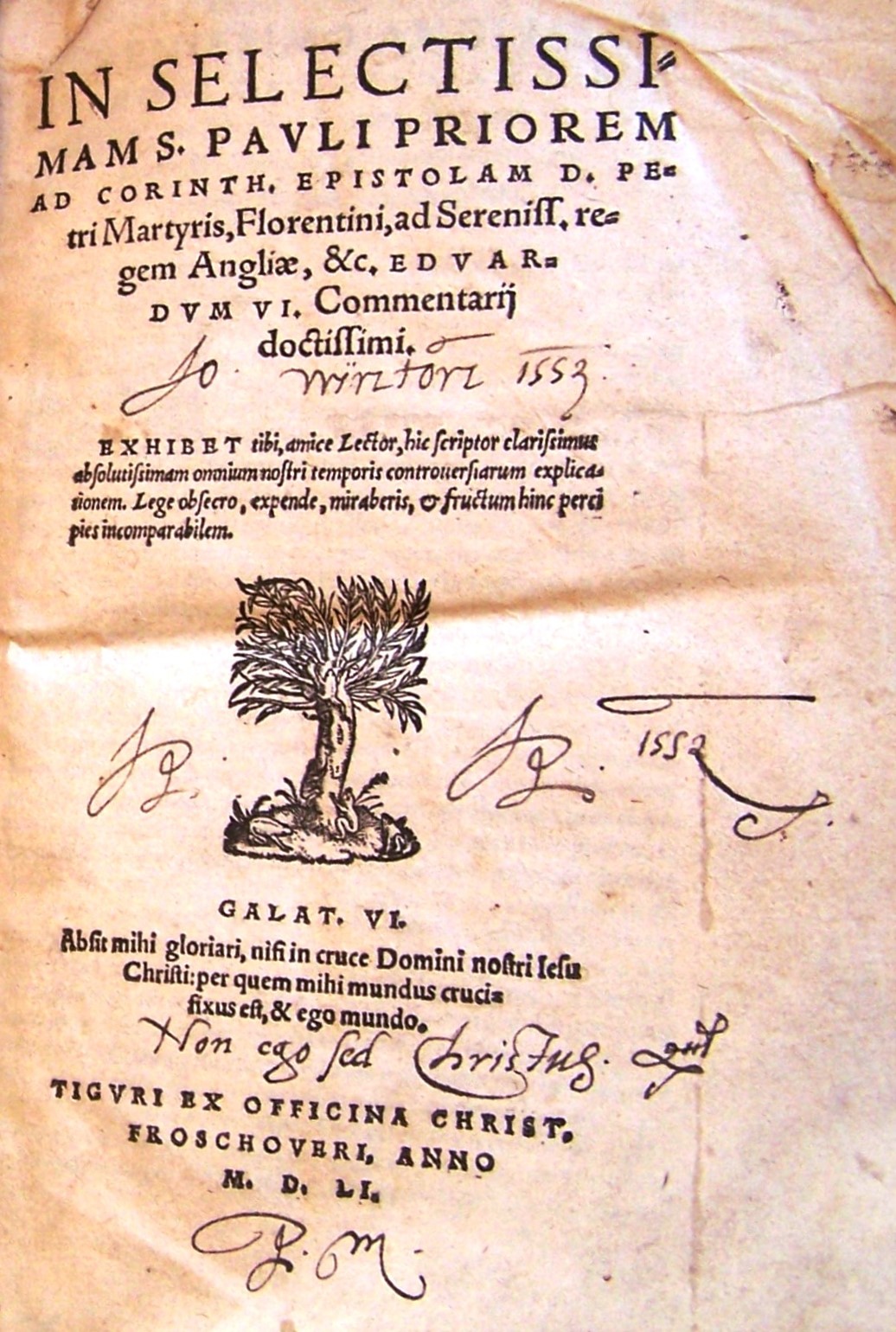
‘J P 1552’ and ‘Jo. Winton 1553’.
Bishop of Winchester (1551-1553) in succession to Stephen Gardiner (1531-1550) who replaced him under Mary (1553-1555). Born (c. 1514) in Kent, graduated at Queen’s College, Cambridge, studying Greek under Thomas Smith (1513-1577); BA 1532/33, MA 1534/35, Fellow (1532), Bursar (1537-1539), Dean (1540-1542); one of Cranmer’s chaplains; canon of Canterbury and proctor (1546); DD 1547; Bishop of Rochester (1550); on the commissions for the suppression of heresy and reform of the ecclesiastical laws (1551); exiled to the continent after the suppression of Wyatt’s rebellion, settling at Strasbourg where he died in 1556. Author of the Short Catechism (1553) and A Short Treatise of Politike Power (1556) among other works. ODNB; Venn; Cooper I, 155-6.
Potter, Thomas.
See Cambridge Franciscan Convent
Pykering, Robert
| 1522 | Erasmus, D. | E31 | N.6.1 | PNL |

‘Dominus meus est domi pykeringus’ with pen trials and two notes in Geste’s hand.
Probably the Robert Pykering who was an older contemporary of Geste at King’s College, Cambridge, admitted (age 16) as a scholar from Eton (1531) from Chichester; Fellow (1534-1549), BA 1535/36, MA 1539, MD 1548; ‘died in Dr Hatcher’s house'(1549). Will proved (1551), leaving 149 items in 224 vols. comprising medical books and a substantial collection of general literature in Latin and Greek, some theology and biblical studies, including works by Erasmus (though this one is not listed), Melanchthon, Luther, Oecolampadius and Bullinger (BiCI, I, no. 52). Venn; Jayne, LCER, 105.
Rochester, St Andrew, Benedictine Cathedral Priory
| 1515 | Seneca | S45 | Y.2.16 | R |
‘Liber claustri Roffensis ex dono magistri Ioannis bambrogh Vicarii de Mallynge’.
John Bambrogh was vicar of Malling, Kent (1517-1524). Ker-Watson, MLGB Suppl., pp. 59, 108, 139, 142 [Bamburgh].
S., W.
| 1556 | Tavernarius, J. | T2 | ZC2.6.3 | PT |
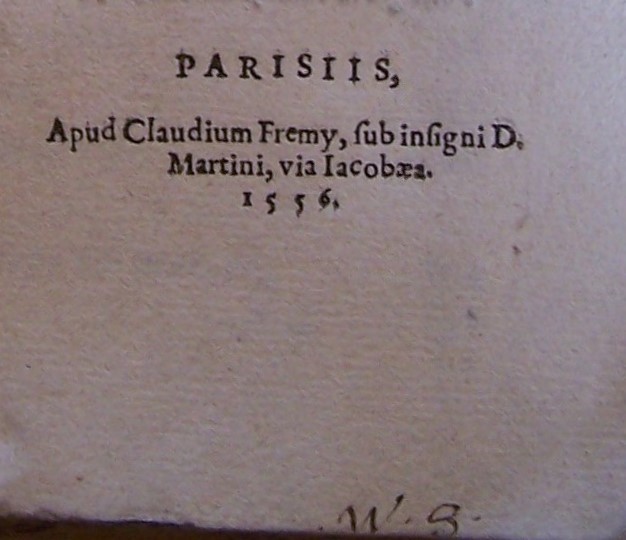
‘W.S.’ at foot of, and top-edge, of tp.
Not identified
Sedyllius[?], Joannis
| 1539 | Bonaventura | B52 | C.4.1 | R |

‘Johan[n]is [?]sedylli[us]’ at top of the titlepage (erased). Reading very uncertain.
Another possibility is ‘Johan[n]is Sedgiwius’.
Not identified
Skypton, Gulielmus
| [c. 1508] | Eusebius, of Cremona | E56 | A.6.32(e) | R |

‘Liber Gulielmi Skypton teste R. Atkynson’.
‘Liber Gulielmi Skypton teste G. Baggleo’.
| 1526 | Bible [Latin] | B35 | G.6.14 | PNL |
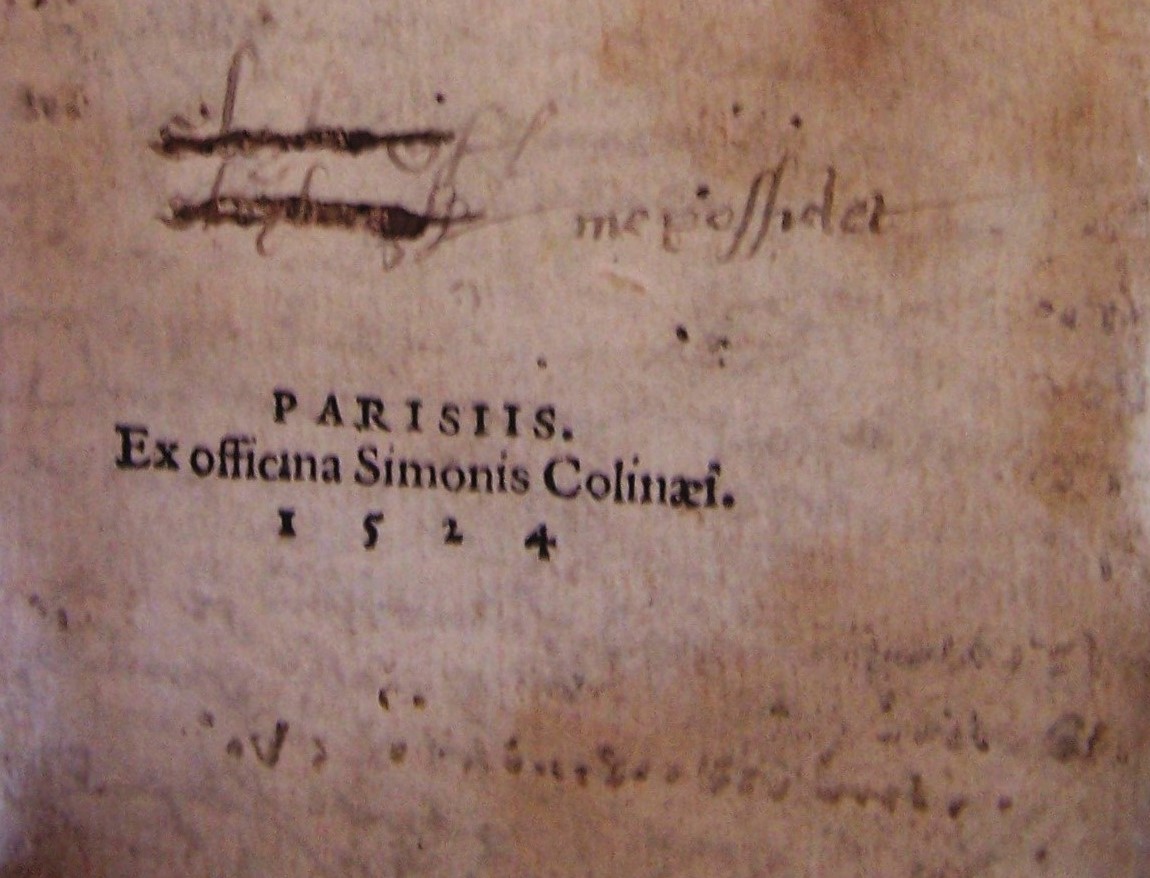
‘Skypton […?] (twice, both erased) me possidet’.
| 1529 | Augustine | A62 | A.6.32(a) | R |
‘liber Gulielmi Skypton teste R. Atkyns[o]n’.
| 1531 | Hugo, de Sancto Charo | H84 | G.2.5 | R |
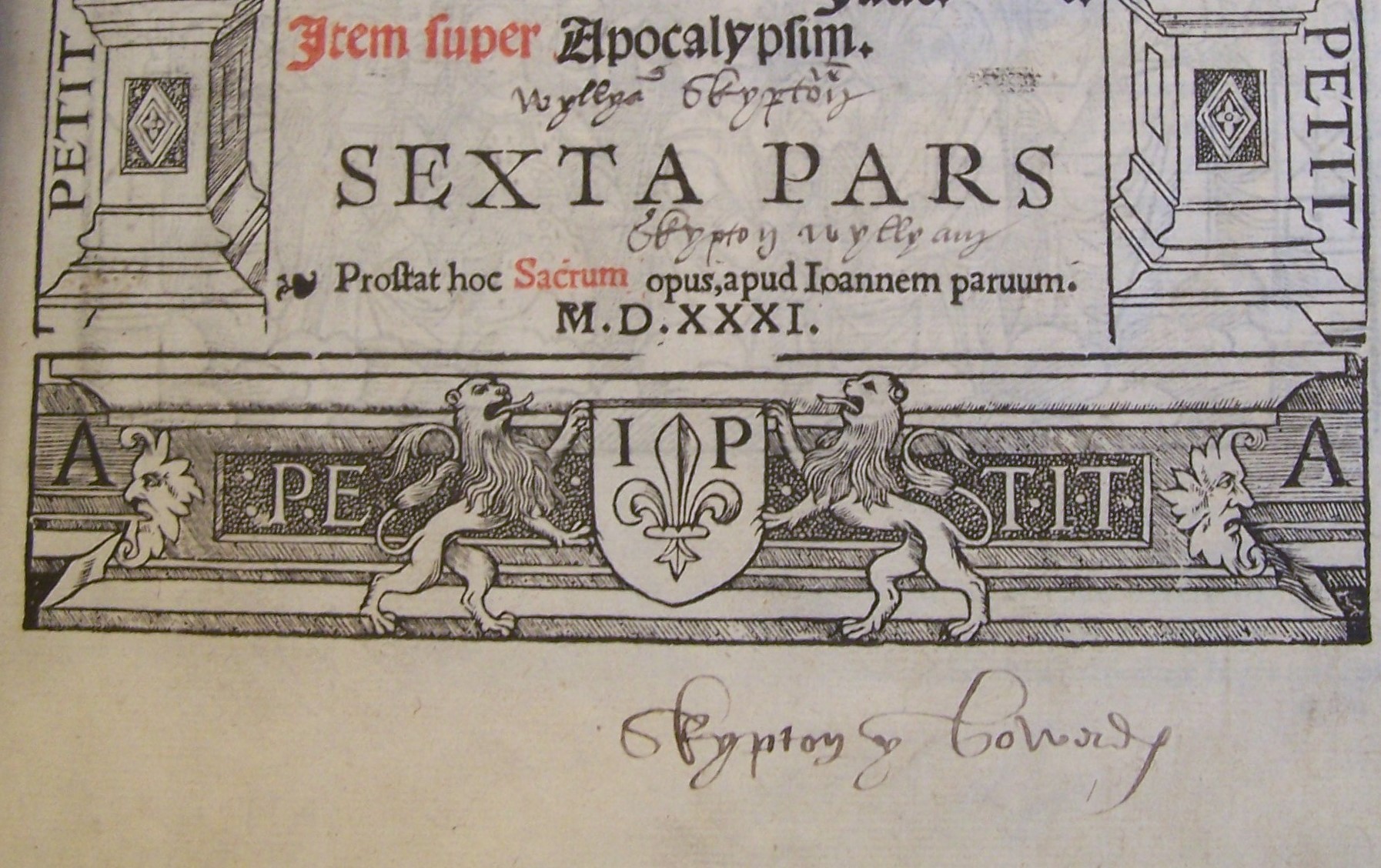
‘Wyllya[m] Skypton’.
‘Skypton wyllya[m]’.
‘Skypton ye how..de’ [?? unidentified]
| 1531 | Tritheim, J. | T20 | B.5.44 | R |
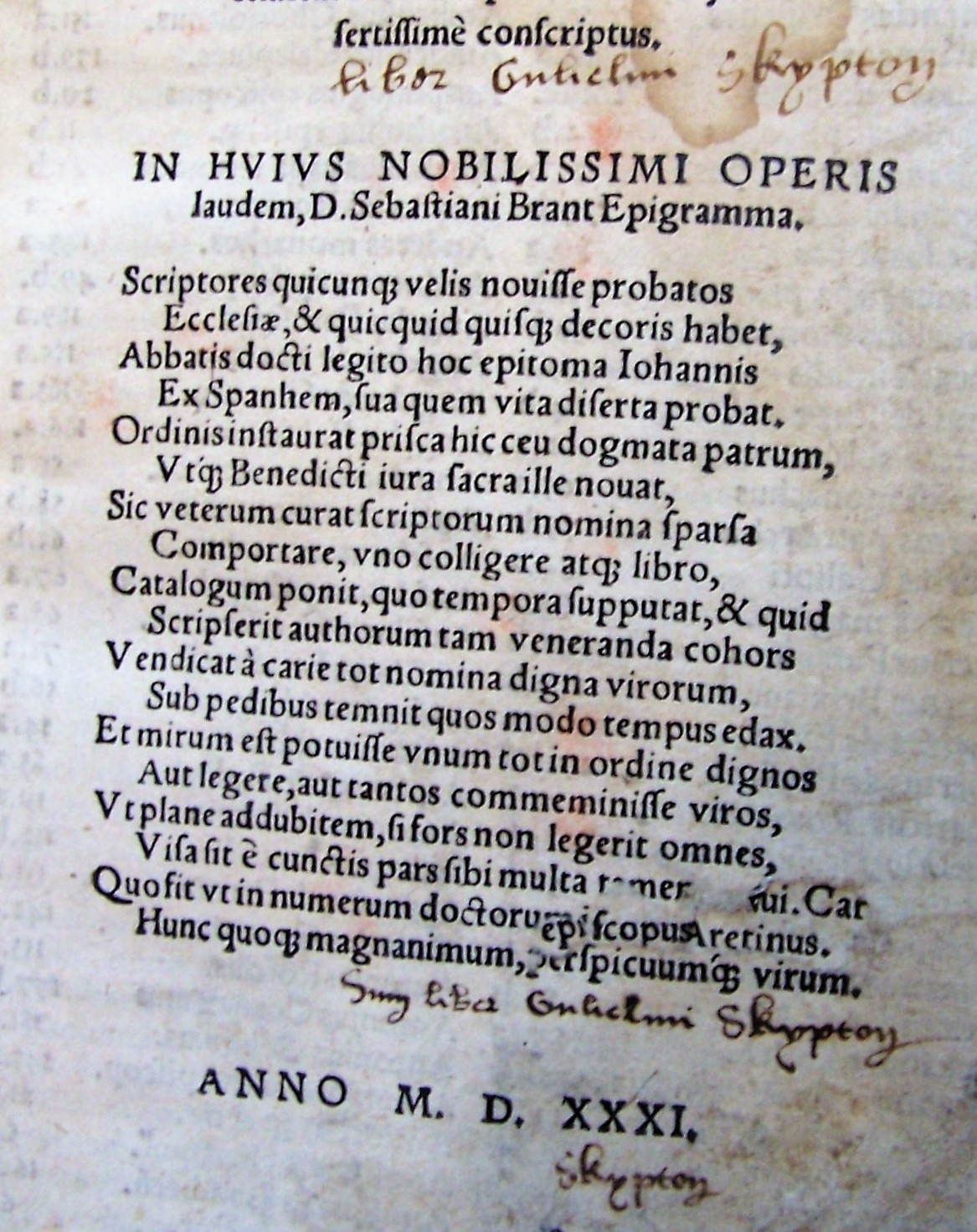
‘liber Gulielmi Skypton’
‘Sum liber Gulielmi Skypton’
‘Skypton’
Older Yorkshire contemporary of Geste at King’s College, Cambridge, admitted as a scholar from Eton in 1522 (age 16) from York. Fellow from 1525 to about 1543. BA 1526/27, MA 1530, BD 1536/37. Ordained deacon (Lincoln) 16 April 1530; priest 11 June 1530. Venn. See also Atkinson, R. and Bagley, W.
Smyth, Thomas
| 1505 | Vivaldus, J. L. | V37 | L.6.1 | R |

‘Liber d[omini] Thomas Smyth’.
The identity of this Thomas Smyth has not been established. It is far from certain that this is the Sir Thomas Smith (1513-1577), scholar, diplomat, and Secretary of State, of Queens’ College, Cambridge, whose library catalogue (1566, rev. 1576) was transcribed in John Strype’s, Life of the learned Sir Thomas Smith kt (1698) [from Queen’s College, MS 49 and 83] and whose Latin and Greek books were left to Queen’s. Cooper, I, 368-73; ODNB; Venn.
Swynne
| 1481 | Duns, J., Scotus. | D33 | L.4.25 | R |
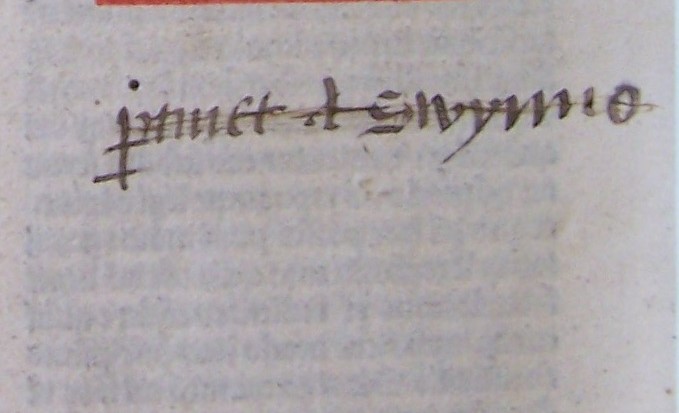
‘Pe[r]tinet A [or ad] Swynno [or Swynne?]’, erased, in a formal fifteenth-century hand on the final leaf of text.
Reading far from certain.
Not identified.
W., W.
| 1541 | Cicero | C74 | X.2.16 | RL/CT |

‘W W’ on covers.
Just possibly the initials of William Wynke, one of Geste’s contem- poraries at King’s College, Cambridge, admitted the same year (1536) and also a scholar from Eton. Fellow (1539-1556); BA 1540/41; MA 1544; BD 1555. Ordained 1551 (Norwich). Succeeded Geste as Vice-Provost, following the former’s removal from office in 1553 and expulsion from King’s in 1554. Vicar of Fordingbridge (Hants.) in 1555. Recusant under Elizabeth I. Venn. Another possibility is William Whitelocke [Whitlock], another of Geste’s contemporaries at Eton and King’s College, Cambridge, admitted the following year (23 August 1537, aged 17) as a scholar. Fellow (1540-1560); BA 1541/42; MA 1545; BD 1553. Vice-provost (1556-1559), following William Wynke. Held livings at Prescot, Lancs. (1558), Greenford, Middlesex (1560) and the stall of Curborough, Lichfield Cathedral (1561), at which he wrote his ‘Chronicon Lichefeldensis ecclesie’ based on earlier chronicles.
Welbeck, Premonstratensian Abbey of, St James.
See Kyrbe, Chrysostom
Weston[us]
| 1540 | Gulielmus, Baufeti | G47 | ZC2.6.12 | PT |
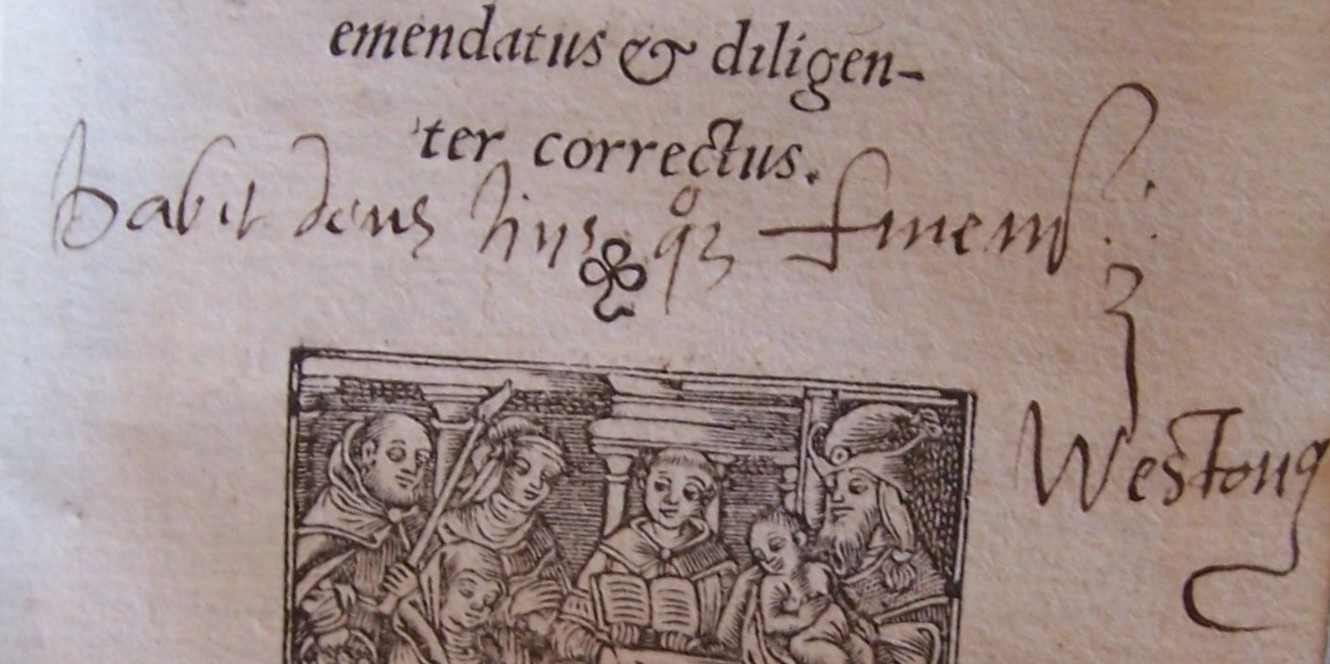
‘Dabit deus hijs q[u]o[?rum] finem
Weston[us]’.
| 1548 | Titelman, F. | T11 | C.5.15 | CS |
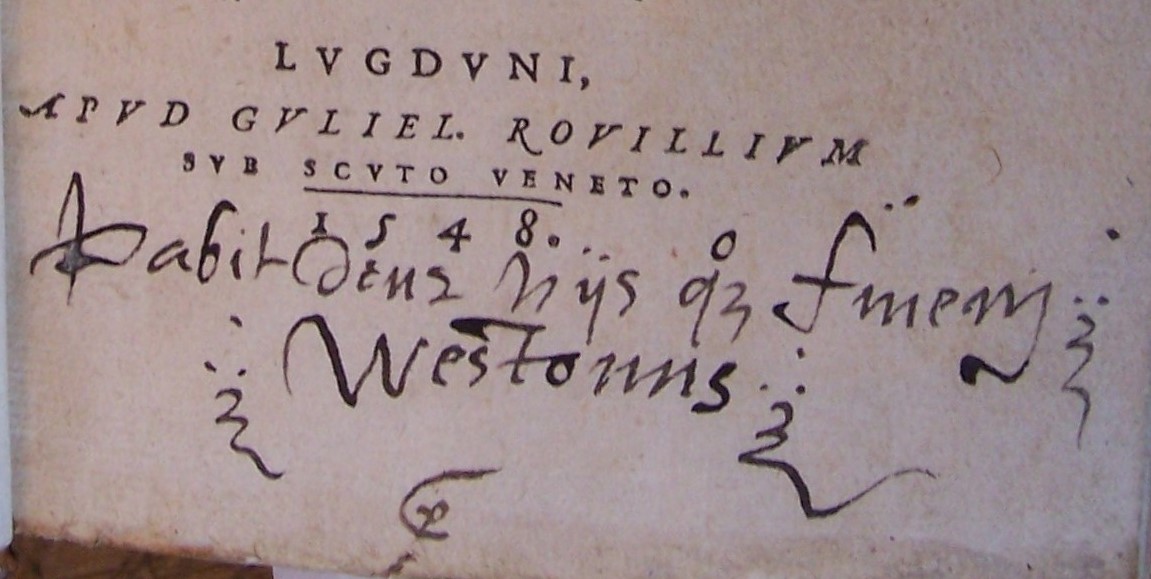
‘Dabit deus hijs q[u]o[?rum] finem
Weston[us]’
Perhaps the Edmund Weston, who held the Yatesbury prebendal stall at Salisbury, 1569-1570. Venn records him as a pensioner at Queens’ College, Cambridge, c. 1545. Another possibility is Hugh Weston (d.1558). Born in Leicestershire, graduated at Balliol College, Oxford, BA 1530, Fellow of Lincoln College, Rector (1538), DD and Lady Margaret Professor (c. 1540), Dean of Westminster (1553), prolocutor of Convocation. Took leading part in Oxford Disputation (1554) against Cranmer, Ridley and Latimer. In 1556 he was obliged to resign the Rectorship of Lincoln College, when Cardinal Pole’s commissioners visited the university, and to exchange the deanery of Westminster for that of Windsor. Deprived (1557) by Pole for adultery and sent to the Tower after attempting to appeal to Rome. Died soon after Elizabeth’s accession (1558). Foster; Cooper I, 187-88.
Whitelocke [Whitlock], William.
See W., W.
Wilkinson, W.
| 1570 | Sonnius, F. | S70 | B.5.33 | PT |
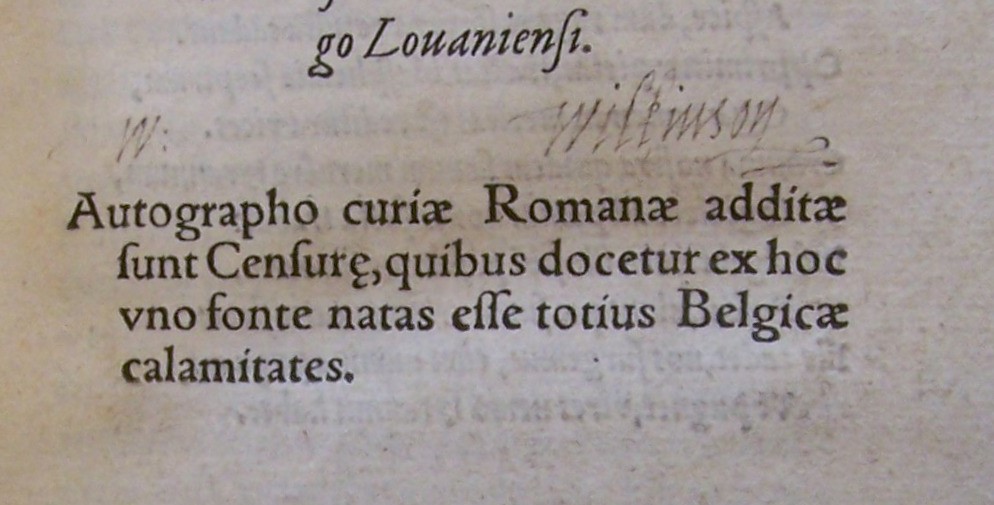
‘W. Wilkinson’ across tp.
Not identified. Post-Geste (see S70).
Williu[m] or Welliu[?m], Thomas
| 1527 | Herodotus | *H2 | Y.3.19(a) | RL |
.jpg)
Pen trials (among others) at top of p. 11.
See also under J., D.
Venn records a Thomas Bawghe, alias Williams, who was a scholar and Fellow of King’s Hall, Cambridge, with an MA 1506/07, BD 1517 and DD 1531, Rector of Dry Drayton (1517-1532), Chancellor of St Paul’s Cathedral (1530-1558) and Archdeacon of Surrey (from 1536). Cooper I, 173.
Wilson, Mr
| [1565] | Jewel, J. | J8 | T.3.3(a) | R |
‘This Book was brought in by Mr […] Wilson’, with a note at the top of the tp. ‘Liber Ecclesiae / Cathed. Saru[m] / 1664’.
Possibly a book that had strayed from the Library during the Interregnum, subsequently returned after the Restoration.
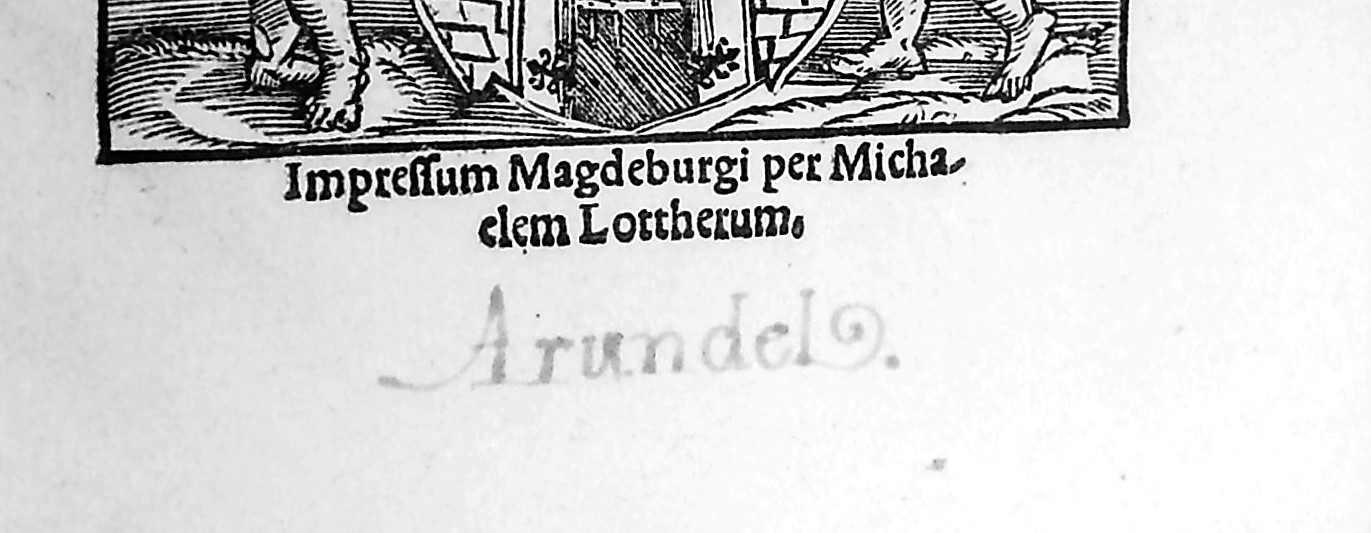
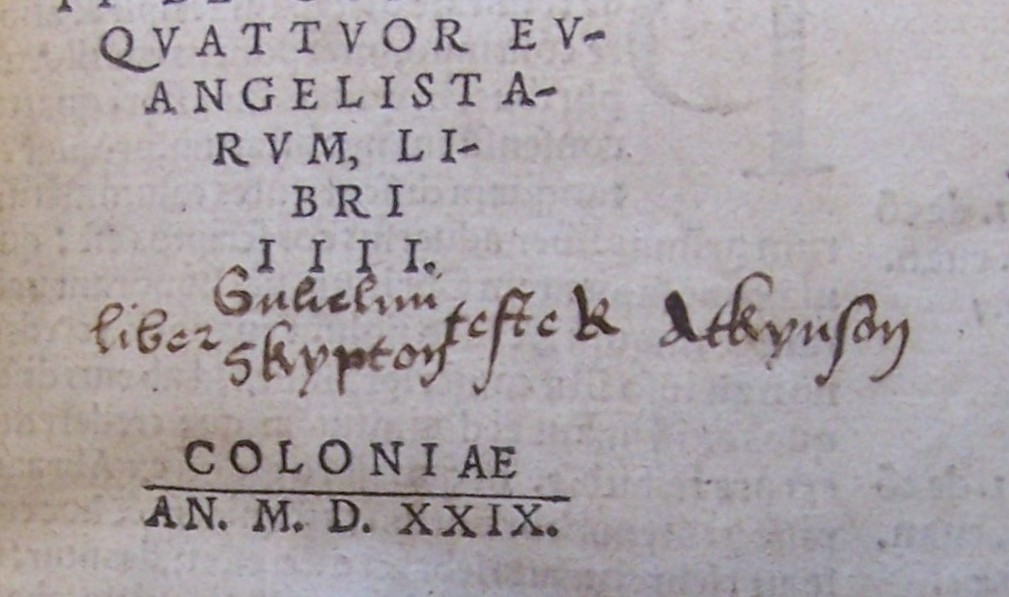
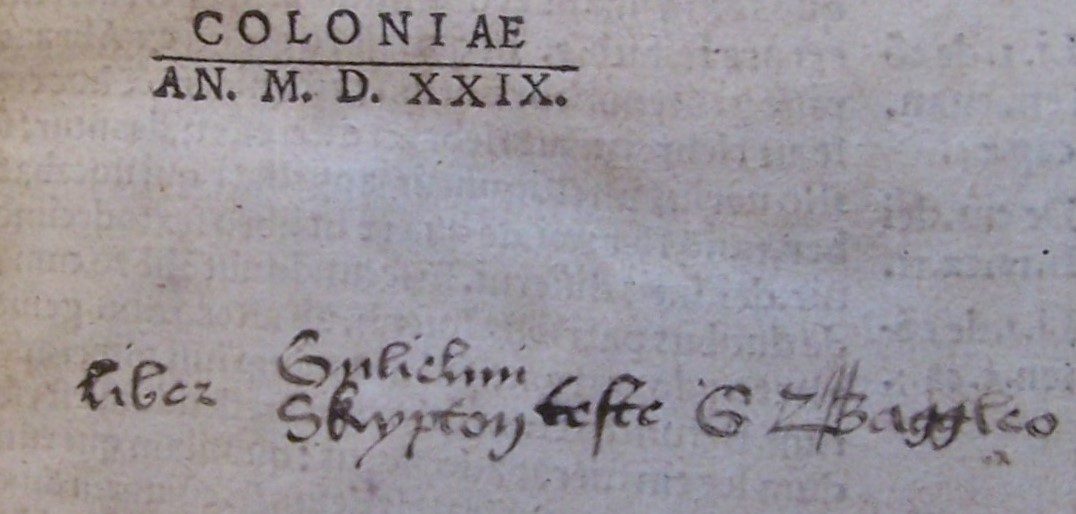

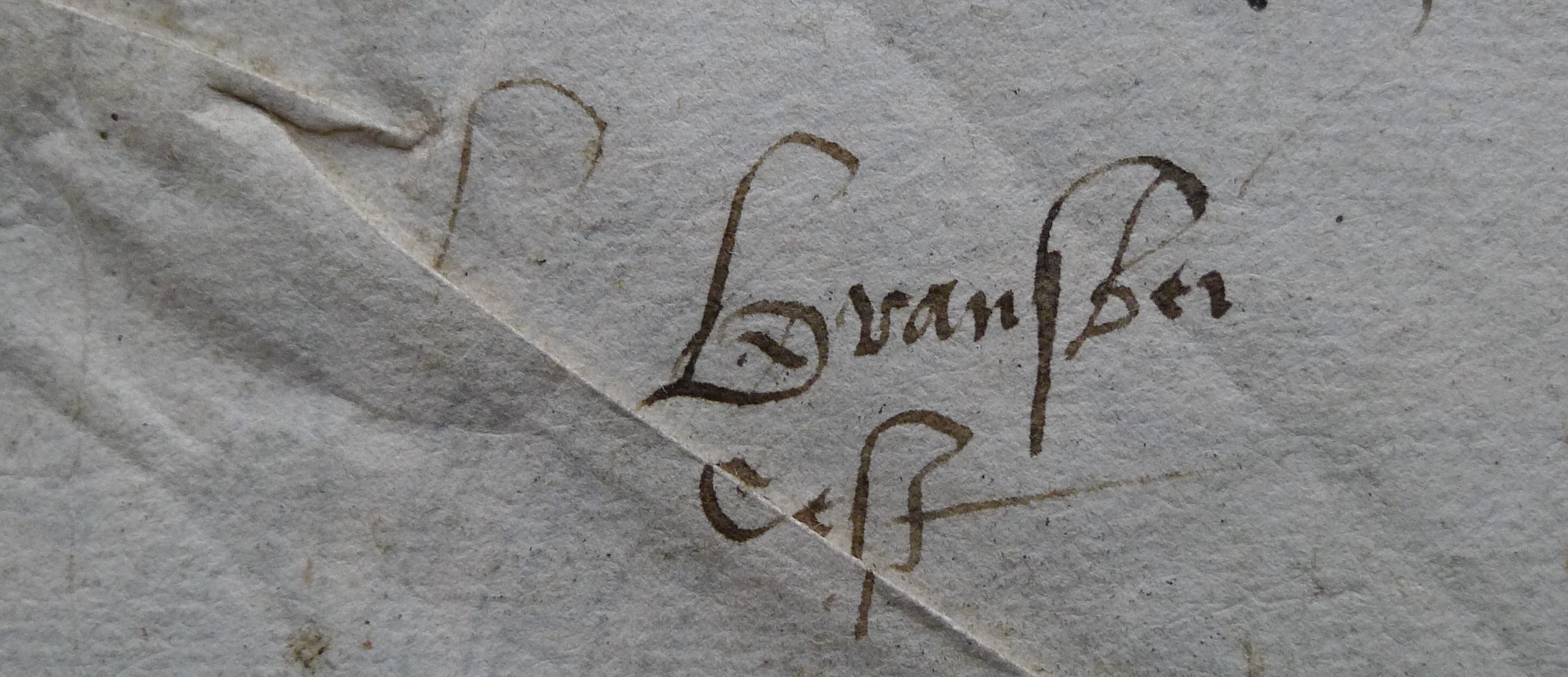

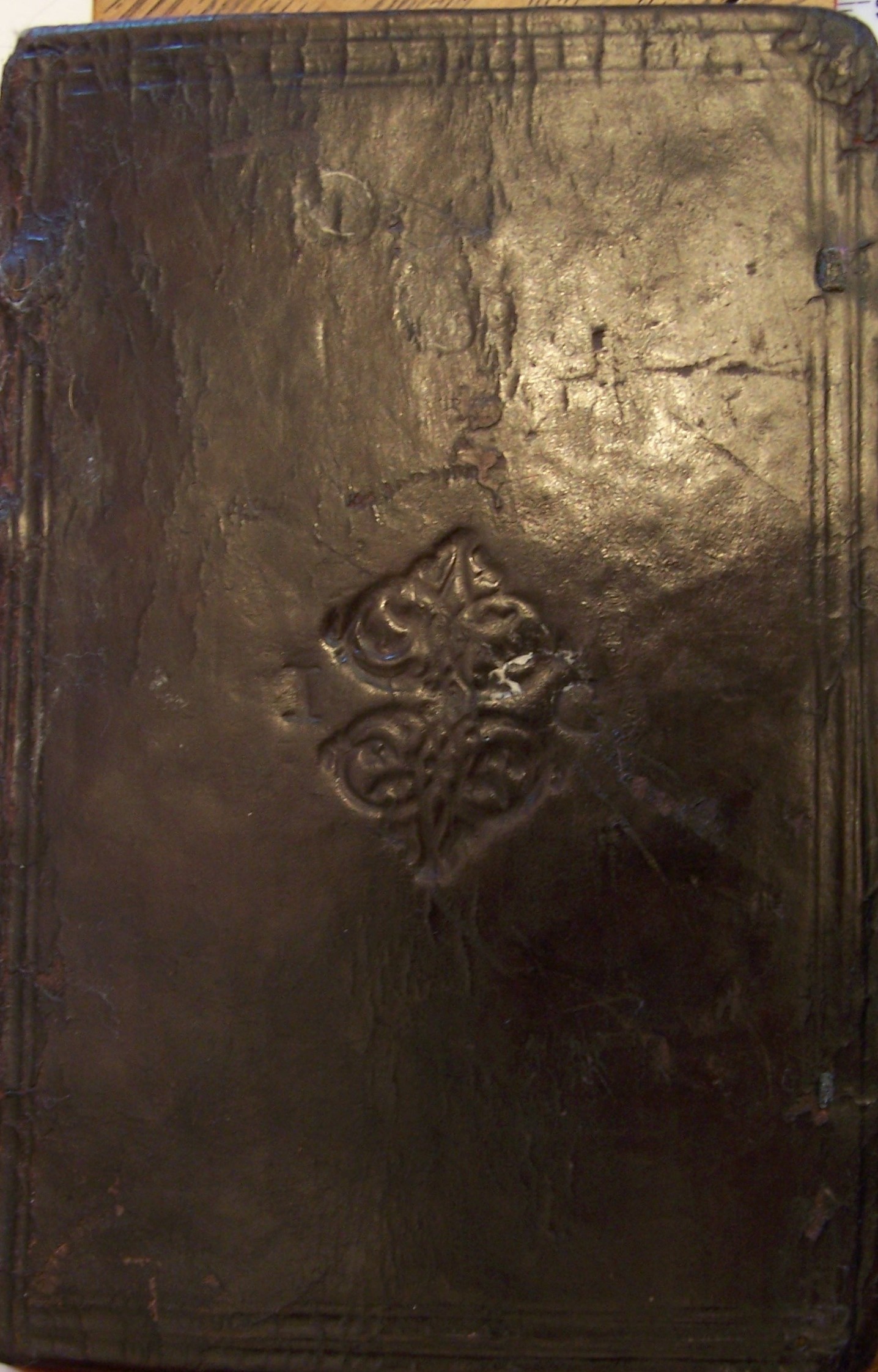
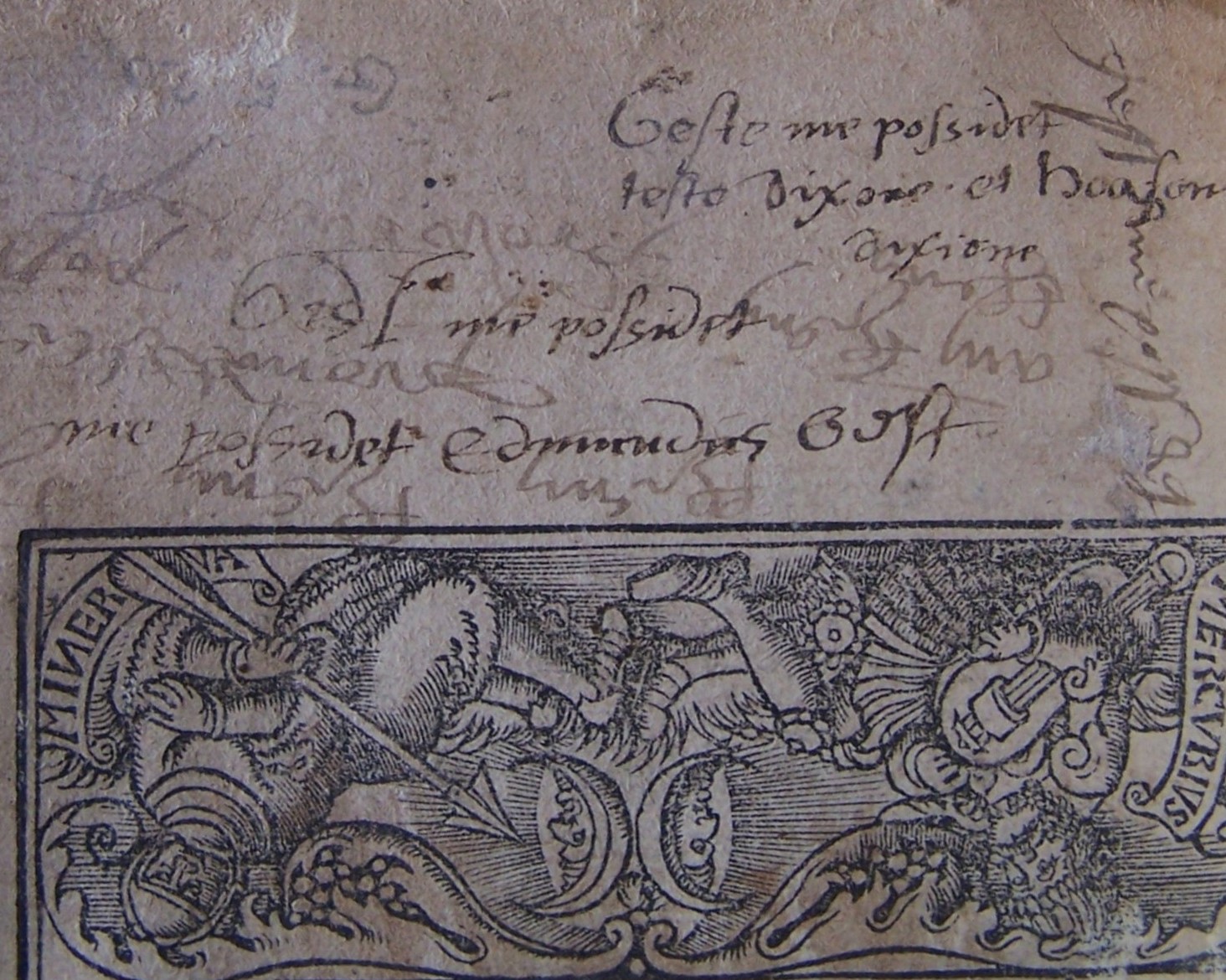
.JPG)
.JPG)
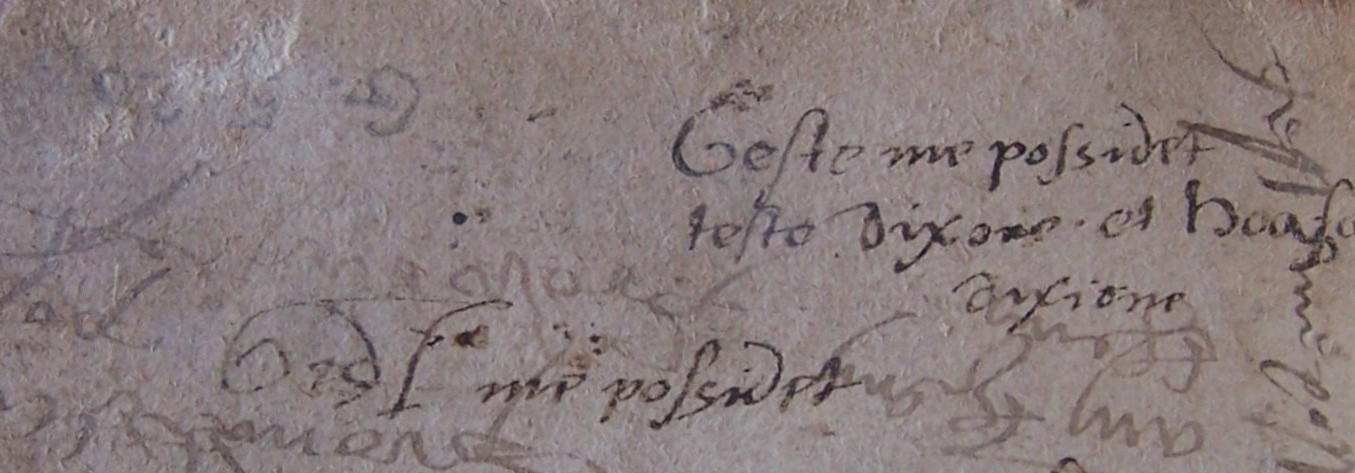
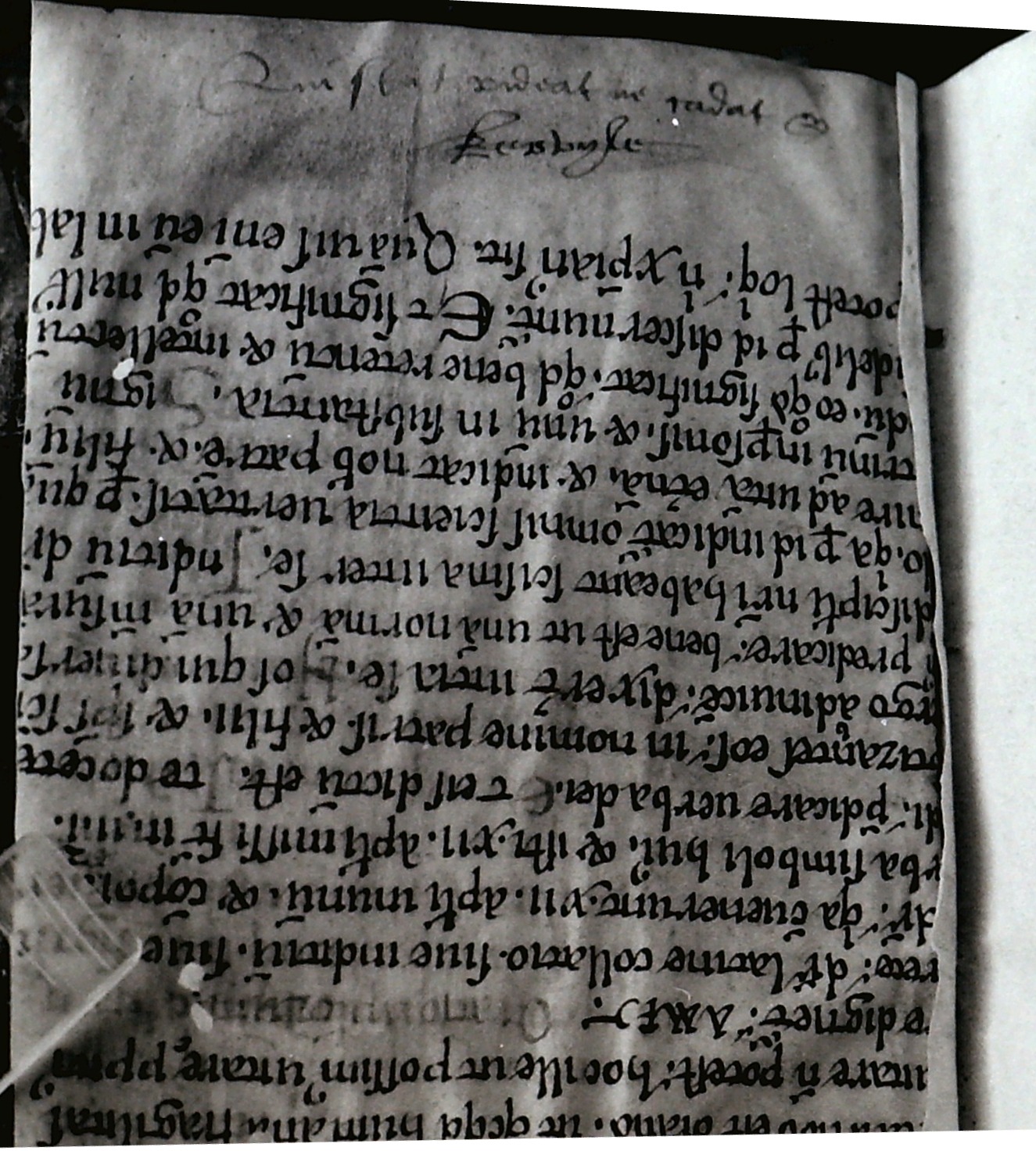

.JPG)
.JPG)

